THE SQUEAKINGS OF DEMOCRACY
George C. Marshall and Congress
by Don DeArmon
In the history of Congress, George C. Marshall—army chief of staff during World War II, secretary of state, secretary of defense—may hold the record for the number of appearances before congressional committees. He deserves the reputation as the most effective advocate ever to appear before and work with Congress, convincing it to act on the most significant decisions of the twentieth century.
Marshall’s success with Congress in the 1930s and 1940s was based on several basic components of his belief system and on his personality traits, which were well-established during his upbringing and during the early stages of his military career.
First, Marshall understood and embraced American democracy in all its forms. He embraced the idea of the citizen-soldier and its role in a democracy. This understanding
Secretary of State George C. Marshall testifies before the Senate Armed Services Committee, March 17, 1948.
3
MARSHALL’S CHARACTER
stemmed heavily from his many experiences with state militias, national guard units, and overseeing Civilian Conservation Corps camps in the 1930s.
Second, Marshall understood and respected the importance of Congress in American democracy. In particular, during his five-year assignment (1919 to 1924) as General John J. Pershing’s chief of staff in Washington, D.C., Marshall interacted daily with members of Congress, and he learned that effective rela-
tions with Congress were essential to approving the army’s budget each year and passing legislation to authorize its activities.
Third, Marshall cultivated relationships with superiors throughout his career and and was willing to speak truth to power. He had two well-known “speaking truth to power” anecdotes—with General Pershing during World War I, and with President Franklin Roosevelt, in November 1938 just after he became deputy chief of staff. But from

4
General Pershing reviewing 1st Troop Philadelphia City
Cavalry with Commanding Officer Clement Wood and Maj. Marshall, February 22, 1922.
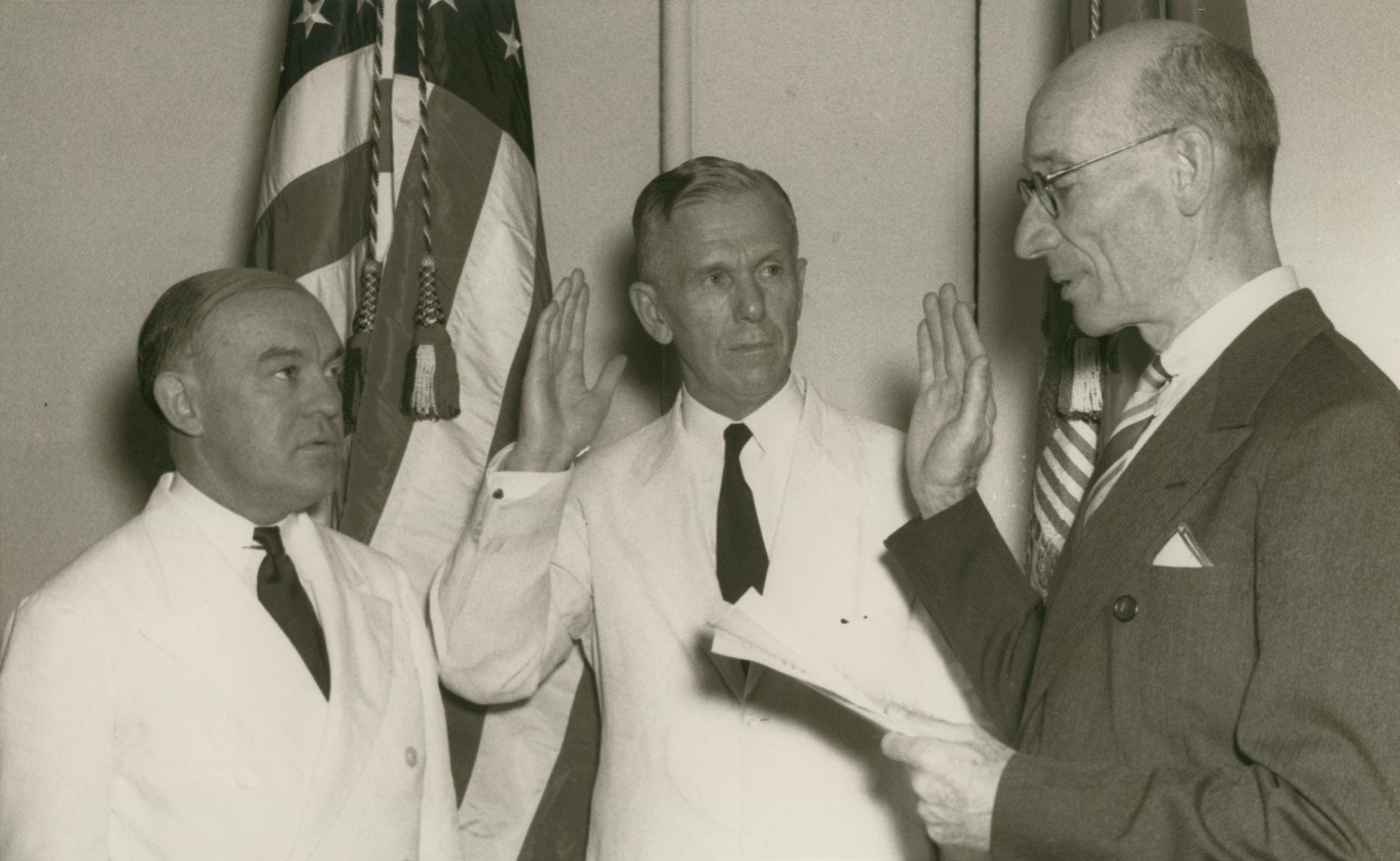
instructing higher-ranking officers at Fort Leavenworth early in his career, to directing generals to move divisions and armies during World War I, Marshall was practiced in dealing directly with superiors in rank.
Last, Marshall was a natural teacher and communicator. He used his strengths to develop effective strategy and tactics in his relations with Congress.
STRATEGY AND TACTICS WITH CONGRESS
Congressmen always knew that when he was testifying before them, they were—according to Speaker of the House Sam Rayburn—“in the presence of a man who is telling us the truth, as he sees it.” Marshall would “tell the truth even if it hurt his cause.”
When Marshall took up his position as deputy chief of staff in Washington in 1938, he was immediately placed in daily contact with Congress. Marshall’s longrunning record in testifying to congressional committees started in January of 1939. In a letter to Brigadier General Philip B. Peyton
he anticipated the start: “I am going before a string of Committees of Congress today and tomorrow, with reporters thicker than flies.”
Marshall had a solid chance to become chief of staff, a four-year billet. He would be working with and testifying to Congress possibly for years to come. How should he go about it? What was the best long-term strategy? He decided upon both strategy and tactics that he would adhere to until the end of his career.
The overall strategy was simple: become the most effective advocate possible on behalf of the U.S. Army and on behalf of the U.S. military in defense of the nation. To do that, take Congress seriously; never forgot that Congress has power over the military and power to provide appropriations, not just at present, but in all the years to come.
His tactics stemmed from the overall strategy: build trust with each congressional encounter. Do not ask Congress for more than is needed. Never deceive Congress, even over something inconsequential, because trust built up over time could be lost.
He had specific tactics for delivering congressional testimony: First, do not testify, converse instead. Second, keep them thoroughly
5
Gen. Marshall being sworn in as chief of staff, September 1, 1939.
Secretary of State Marshall, flanked by Under Secretary of State Robert Lovett, testifying before the Senate Foreign Relations Committee on European Recovery, November 1947.
informed because members of Congress hate surprises. Answer their questions straight-forwardly. So third, be as prepared and informed as possible. If you do not know something, do not pretend to know. Get back to them quickly with follow-up information if it is needed— and do it that same day.
Marshall’s directives while at Fort Benning where he ordered instructors not to read lectures or even consult notes, he took to heart in appearing before Congress. He explained why to biographer Forrest C. Pogue: “You see, I’d been doing this with Congress all the time without any notes, because I found that the minute you began to read you lost your audience. It was better to forget something.”
Other parts of his tactics were more mundane but also important. Until December 7, 1941, he testified in civilian clothes to avoid any appearance of trying to impress members of Congress with medals or martial ostentation. Marshall did not hunch over the witness table reading from a prepared statement; he often had not prepared a statement. He relaxed; he pushed back from the witness table and placed one leg over the other. He wanted to establish a conversation of equals—government officials playing their roles. He was always deferential and would also flatter them or emphasize their own role with phrases such as: “As you know far better than me.”
Scan the QR code to access hundreds of resources about Marshall and Congress:
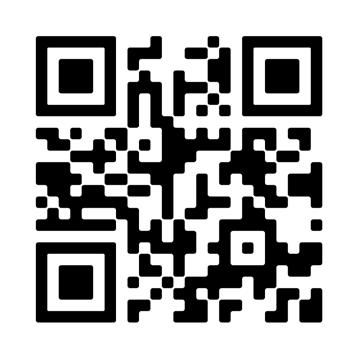
Before the U.S. declared war, Marshall rarely had aides accompany him. He did not want to rely on aides, and he did not want members of Congress to think he had to rely on them. He also did not want to disturb the atmosphere of the hearing by interrupting the conversation to turn to aides. Later, during the war, he would have two aides available, in case detail was needed in order to cut down on the resources required to followup con-
gressional inquiries that could not be answered immediately.
All these tactics were designed by Marshall to establish intimacy with members of Congress so that they would have complete confidence in him and trust what he said.
Biographer William Frye described Marshall’s prewar tactics in a somewhat less admiring way:
To believe that the personality Marshall projected before Congress was totally natural is naïve. While clearly based on everyday characteristics and values, that image was as much a conscious creation as his command image before troops. As he had throughout his life, he was once again projecting an appearance of full control, understanding, and calm that did not and could not truly exist but that had to be reassuring to a Congress nearly hysterical over the events occurring in Europe.
Frye continued: “‘Marshall is the most accomplished actor in the Army,’ one official who worked closely with him noted. ‘Everybody thinks MacArthur is, but he’s not. The difference between them is that you always know MacArthur is acting.’”
Perhaps part of it was an act. But unless Marshall truly held a sincere belief in democracy and Congress’s role in it, the act would not have been effective over time.
Marshall’s attitude toward Congress was demonstrated by his reaction to the establishment of the Special Committee to Investigate the National Defense Program—the so-called [Sen. Harry] Truman Committee—in 1941. Historian Ed Cray observed: “Initially apprehensive that the Truman Committee might attempt to run the war from Capitol Hill, Marshall decided to treat it as he had all other congressional bodies, with deference and candor.” He went on to quote Marshall: “It seems
6
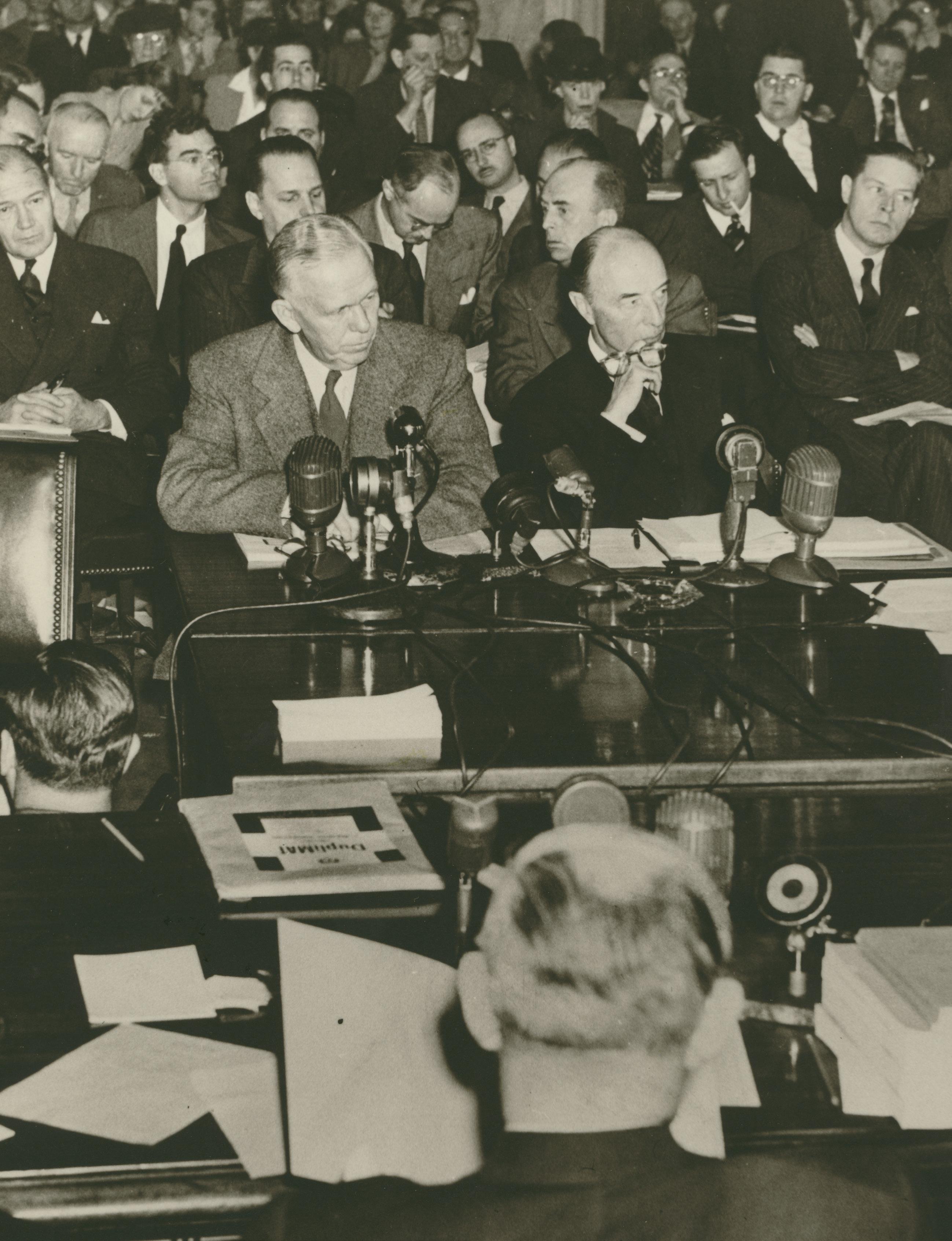
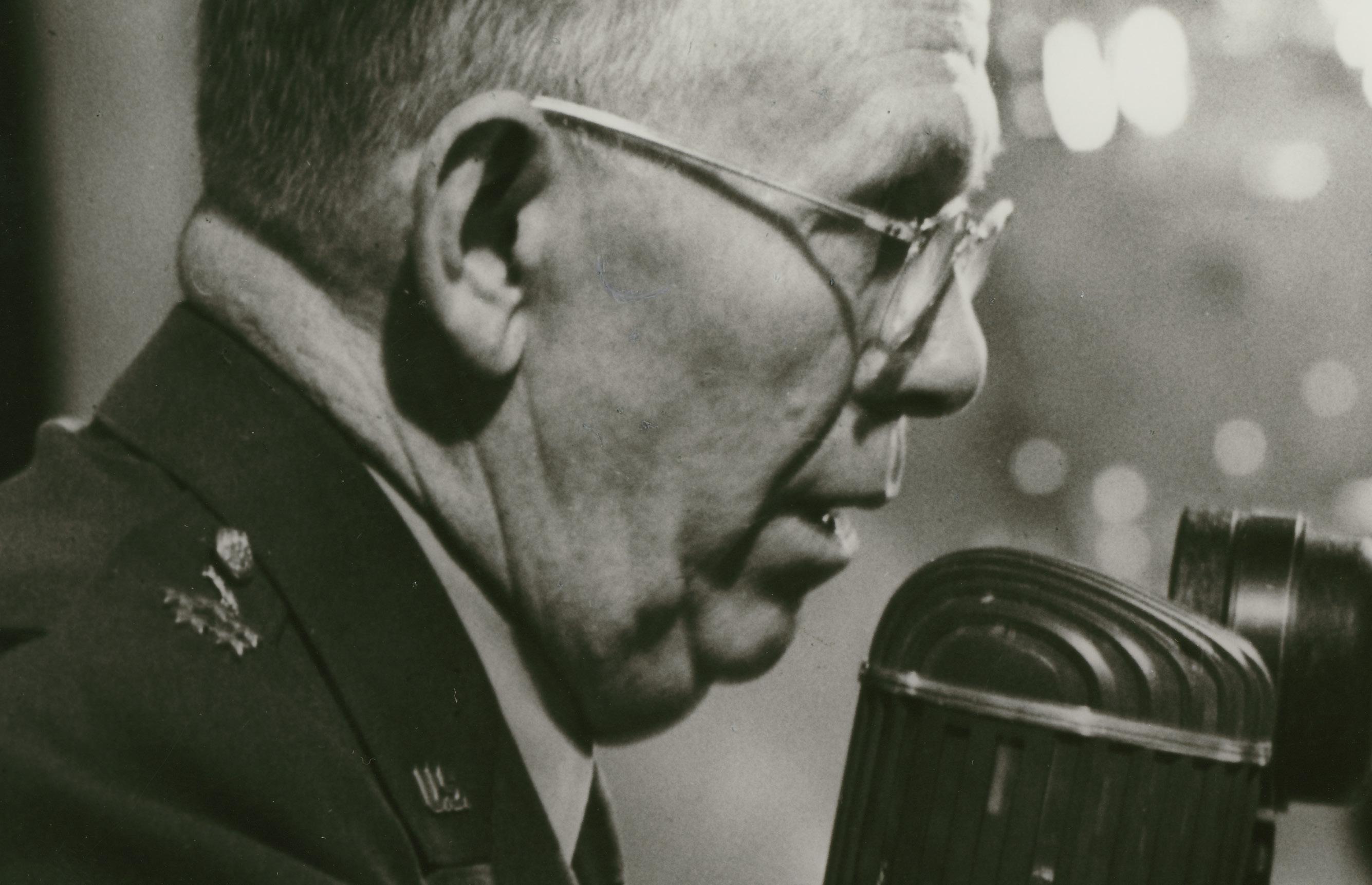
General Marshall speaks into a large microphone while testifying before the Joint Committee on the Investigation of the Pearl Harbor Attack, December 1945.
to me that a free and easy and whole-souled manner of cooperation with these committees is more likely to create an impression that everything is all right in the War Department, than is a resentful attitude, and that it must be assumed that members of Congress are just as patriotic as we.”
Historian Mark A. Stoler perhaps summed it up best: “In congressional hearings, Marshall was able to project an effective image of cool professionalism, thorough mastery of the facts, truthfulness, and nonpartisanship. Partially this image was an accurate reflection of his character and personality. He was, simply put, all that he seemed to be. He was also charismatic, and his aura of authority,leadership, and control extended beyond the military realm.”
Marshall’s philosophy and attitude in
navigating the storms of Capitol Hill successfully were perhaps embodied in his 1942 reaction to a colonel’s protest about congressional criticism of the army: “I think you have allowed yourself to be unduly irritated by the squeakings of Democracy.”
THE PAY-OFF
The first crucial period during which all of George Marshall’s lessons in dealing with Congress came to a head was in the interval between September 1, 1939—the first day of World War II—and December 7, 1941. Coincidentally, Marshall took over officially as Army chief of staff on that first day of World War II.
8
Marshall was determined not to hide harsh truths from the nation’s leaders.”
HISTORIAN LARRY BLAND

For the next twenty-seven months, Marshall and President Roosevelt worked to convince a reluctant Congress, reflecting reluctant Americans, to build up America’s military. It was an extremely turbulent time for the United States, as an active anti-war campaign led by Charles Lindbergh challenged every move that seemed to prepare for war. Author Lynne Olson, writing in detail about those two years, aptly titled her book, Those Angry Days
Despite opposition, Marshall and Roosevelt were largely successful. In addition to increasing appropriations and authorizing a significant build-up in military forces, legislative victories included passage of the Selective Service Act in 1940 and its renewal one year later, just a few months
before Pearl Harbor.
Marshall worked with Congress through a rapidly changing international situation, especially after the quick succession of German military victories in western Europe in 1940. Having received congressional approval for what were at the time unprecedented financial resources, he had to go back again and again, sometimes within a short period of time, to ask for even more.
Marshall testified to Congress on five occasions in 1939 once he became acting chief of staff. That pace accelerated in 1940 after the war began. Mark Stoler reported that Marshall made seven trips to the Capitol between May 29 and June 5; from April through September, he spent twenty-one days testifying at fifteen different hearings, a total of thirty-two
9
Secretary of State Marshall testifying before the House Foreign Affairs Committee on China Aid Program, February 20, 1948.
occasions by the end of 1940.
Ever the non-politician, Marshall’s influence with members of Congress was not confined to committee hearings, but he was not always successful. Congress originally cut his funding request in 1940 by 10 percent.
The cut led to a notable dinner meeting with influential senators on April 10, 1940, set up by Bernard Baruch and Senator James Byrnes, where Marshall spoke passionately about the army’s needs and convinced several senators who had been against robust military budgets that military preparation was vital. When Marshall lamented at his ineffectiveness in convincing them, Senator Alva Adams, who had been skeptical previously, told him, “You came before the committee without even a piece of paper and got every goddamn thing you asked for.”In 1940, Marshall was one of the key strategists who convinced Congress to enact the first peacetime draft in U.S. history. Marshall’s discipline—just one year after becoming chief of staff—was apparent. Even while his own staff was drafting language and
supplying such civilian proponents of the military as Grenville Clark with information, Marshall held off commenting officially until Congress asked for the army’s opinion. That timing gave his advocacy maximum effectiveness. Passage of the draft represented an enormous legislative victory; even Speaker Sam Rayburn originally predicted that there were insufficient votes to pass it.
The extension of the draft in 1941 may have been an even greater legislative accomplishment, with Marshall this time definitely taking the lead. The one-vote margin in the House was perhaps a last, wistful reflection that Americans could somehow stay out of the European war. That viewpoint was not altogether surprising at a time when Britain seemed to have beaten back a possible German invasion of the British Isles, and the Nazis had turned their attention to the Soviet Union.
Although Marshall normally dealt with a relatively small group of congressional leaders on military issues, he was ever aware of the votes required on the floor of the House and Senate
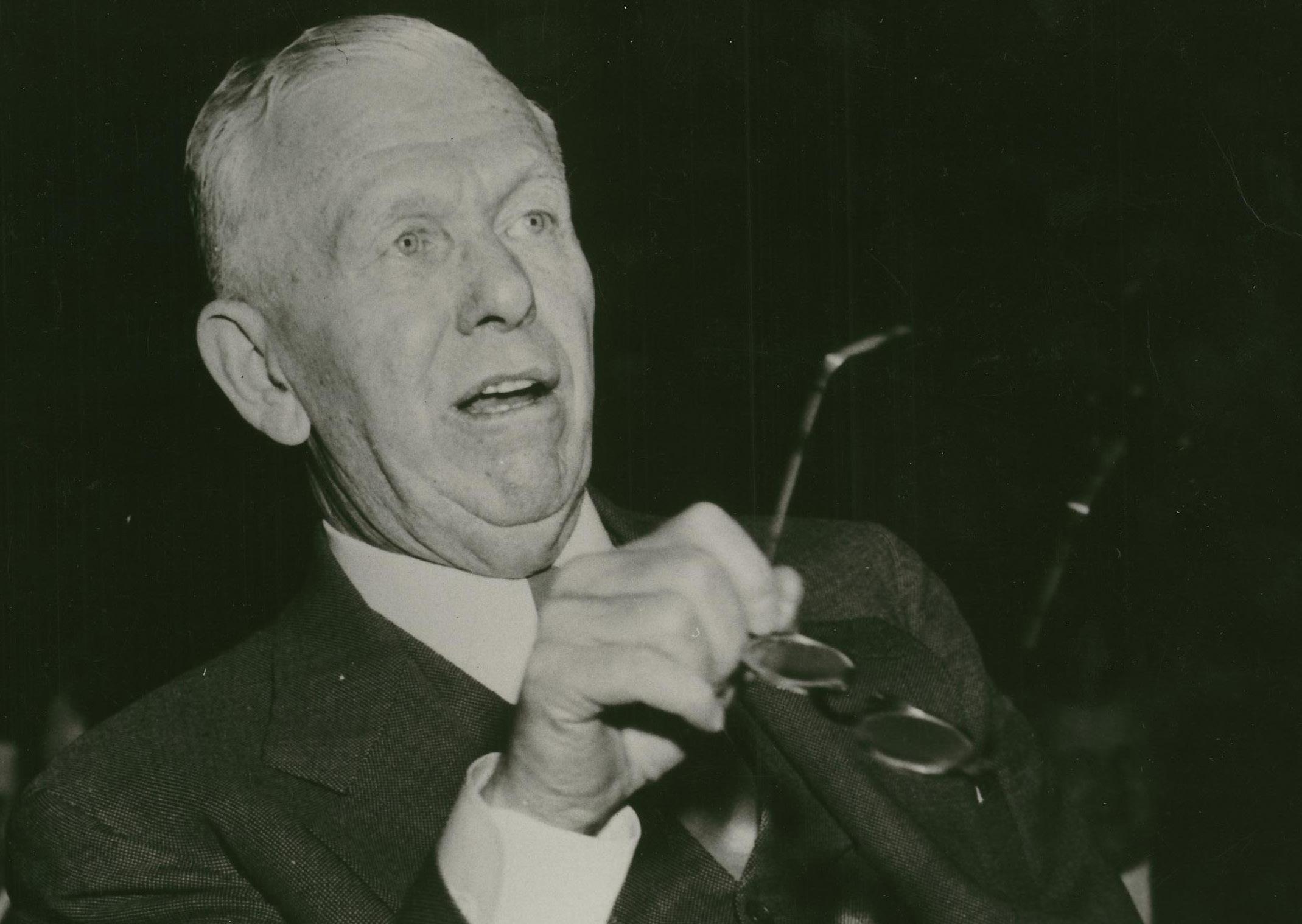
10

to enact legislation in final form. As a result, he kept attuned to American public opinion generally. His inspection tours of army installations around the United States also kept him in touch with state con-gressional delegations and regional newspapers and opinion.
He also understood the need to massage popular opinion, and he used public addresses to send a consistent message about the need for defense build-up. In a notable case while extension of the draft was being debated, he personally drafted a biennial report on the state of the army and orchestrated press coverage of the report in order to grab the public’s attention. But as with his congressional testimony, the ultimate target of that message, buttressed by public opinion, was Congress.
Marshall’s reputation as a master in dealing effectively with Congress probably worked against his personal aspirations. When General Pershing, Secretary of War Henry Stimson, and others advising President Roosevelt recommended against Marshall’s appointment as commander of Operation Overlord in late 1942, their opposition was based heavily on Marshall’s knowledge of and effectiveness in dealing with Congress.
Perhaps, based on the events in Europe, Congress would have acted the same way for any chief of staff and built up forces and expended record amounts of money. Perhaps, without Marshall’s reputation and advocacy, Congress would have enacted a draft, then extended it. But Marshall’s steady hand with Congress
11
Left to right: Sen. Arthur H. Vandenberg (RMI), Sen. Alben Barkley (DKY), Rep. Sam Rayburn (DTX), Marshall, Undersecretary of State Dean Acheson. April 27, 1947.
Secretary of State Marshall rests his head on his hand during hearings before the Senate Committee on Foreign Relations on the European Recovery Program.
placed the U.S. in the best military posture that probably could have been accomplished in those “angry days” immediately before a reluctant populace was forced into war.
CONGRESSIONAL ENCORE: THE MARSHALL PLAN
Marshall had intended to retire to his home in Leesburg, Virginia, at the end of World War II, so it is somewhat ironic that all the lessons he had learned about Congress, and the reputation he had built over time, culminated in a huge legislative victory after he took on a role he had not anticipated in 1945—secretary of state.
Some historians discount Marshall’s contribution to the Marshall Plan, pointing out that the idea to help with Europe’s economic recovery was long-standing, that Senator Arthur Vandenberg and others deserved the lion’s share of credit for marshaling congressional support, and that events in Eastern Europe drove Congress to enact the funds.
But Marshall was the quarterback of a team that executed a successful game plan, and without George C. Marshall, it is unlikely there would have been a Marshall Plan of the type and magnitude enacted by Congress.The campaign for passage of the European Economic Recovery Plan included all the elements that Marshall had learned over the course of his career in dealing with Congress.
Communication and education: Marshall carefully chose the timing and venue of Harvard University to outline the plan. In educating Congress, he used two well-worn techniques from his career: First, he testified twenty-five times between the speech and the Marshall Plan’s final enactment in April 1948. Second, just as earlier in his army career he had educated local officials by inviting them to the military bases he had commanded, he organized a series of “CODELS”—congressional delegation visits—to Europe so members of Congress could see the problem firsthand. More than
150 members of Congress traveled to Europe during 1947. These were not weekend junkets to comfortable capitals. Members of Congress visited war-torn areas of Europe for up to six weeks and collectively visited every one of the affected countries. Both Republicans—who now controlled the House and Senate—and Democrats came home convinced of the need to act.
Relationships: Although the State Department developed and drafted the legislation, Marshall enlisted a key congressional ally, Senator Arthur Vandenberg, chair of the Senate Committee on Foreign Relations—a well-regarded and influential member of the majority Republicans—as the congressional leader of the effort.
To win congressional support, especially from Republicans, Marshall compromised on the details of the legislation again and again. A less-experienced operative would have bristled at the compromises, or been indignant at the opposition, or would have tired of the need to repeat the arguments over and over. Instead, Marshall recognized it all as democracy in action.
Citizen-soldiers: Marshall had been ever mindful throughout his career that in a democracy the general populace of citizen-soldiers decides the nation’s course. The voters had elected a Republican Congress in 1946 that, under normal circumstances, would have been both isolationist and frugal when it came to foreign aid. Marshall undertook a national speaking tour and gave fourteen major addresses. He recognized that public support would be necessary to sustain the Marshall Plan effort over several years. And he understood that members of Congress would need that public support if they were to cast tough votes on generous foreign aid.
Looking back, it is easy to think that passage of the Marshall Plan was perhaps inevitable. It was anything but inevitable. A Republican-controlled Congress passed the largest foreign aid program in the history of the world, and it did so during one of the
12
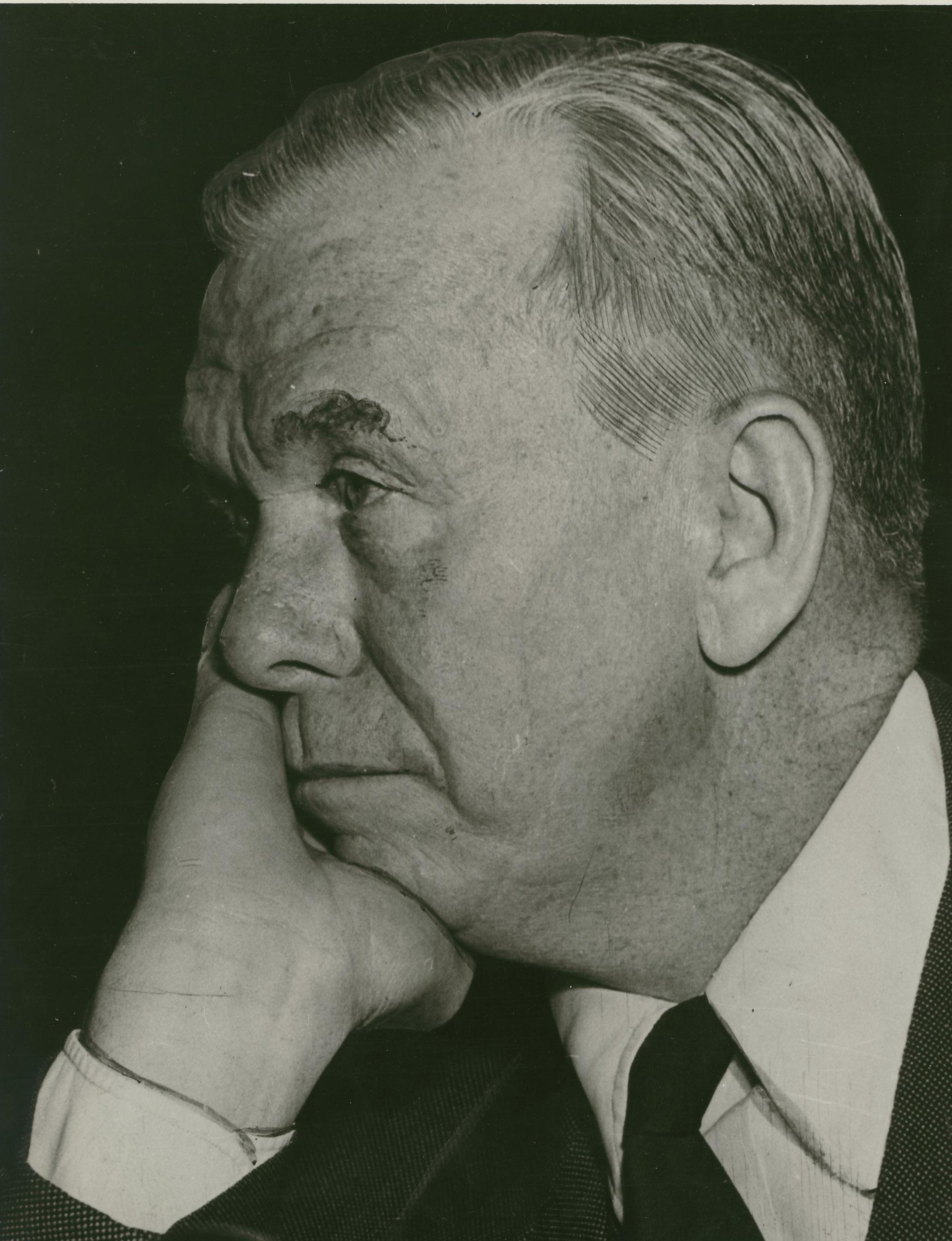
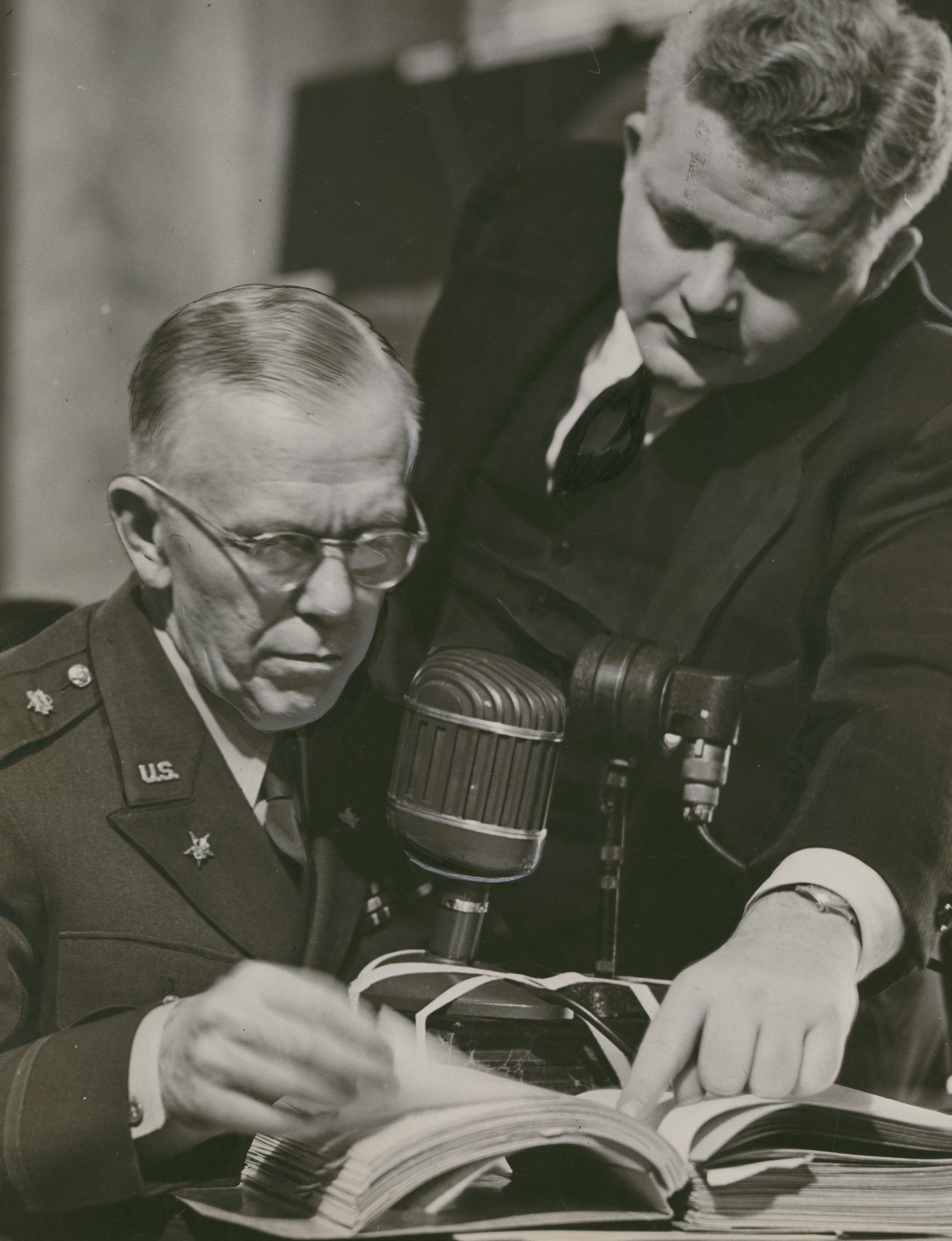
most contentious presidential election years of the twentieth century. Republican fears about political risks were well founded; Democrats took back control of both House and Senate in the November 1948 election.
In 1953, Marshall was awarded the Nobel Peace Prize in recognition of the success of the Marshall Plan. In accepting the award, Marshall declared, “I do it not merely for myself, more specially for the American people who, alone, made possible the authority and possible the funds which made the European recovery program a reality.”
Marshall’s tombstone at Arlington National Cemetery enumerates several personal accomplishments: army chief of staff, secretary of state, secretary of defense, president of the American Red Cross. The Nobel Peace Prize is not etched there. Marshall never considered it his singular honor. He meant it when he accepted the prize on behalf of the American people.
A COMMITMENT TO AND AN UNDERSTANDING OF DEMOCRACY
George C. Marshall’s commitment to democracy, his astute observations of Congress and its members over many decades, as well as all his personal characteristics developed over the course of his long career, made him the perfect agent and principal in dealing with Congress before World War II, during the war, and during the post-war period when so many important decisions reaching into the 21st century were made. There are numerous lessons in Marshall’s career for anyone wanting to work effectively with Congress. On September 25, 1945, Marshall made somewhat of a valedictory appearance before the House Appropriations Committee. It was a scant six weeks after V-J Day.
Clarence Cannon, the chairman, praised Marshall, noting that since 1940 the committee had appropriated $200 billion “largely on your recommendations, and…it has all
been well spent.” Cannon said he had been impressed by Marshall’s “appreciation of the fact that the military point of view must be tempered by financial considerations, and especially by your charity in realizing that the political implications under which the committee moves may affect the situation.”
Marshall, the consummate citizen-soldier, summed up his entire career and, in particular, his respect for Congress when he responded: “It was not charity but an understanding of democracy.”
Gen. Marshall and Gerhard Gesell flip through a book while Marshall is testifying before the Joint Committee on the Investigation of the Pearl Harbor Attack, December 1945.
Don DeArmon worked in Capitol Hill offices for 28 years and spent another six years as a lobbyist for nonprofit organizations. He graduated from the University of North Carolina at Chapel Hill with a BA in American history. He lives in Frederick, Maryland, with his wife, Ann.
“The American people do not, as a general rule, like or trust the military. But they like and trust George Marshall … The secret is that American democracy is the stuff Marshall is made of.”
TIME, 1943
15
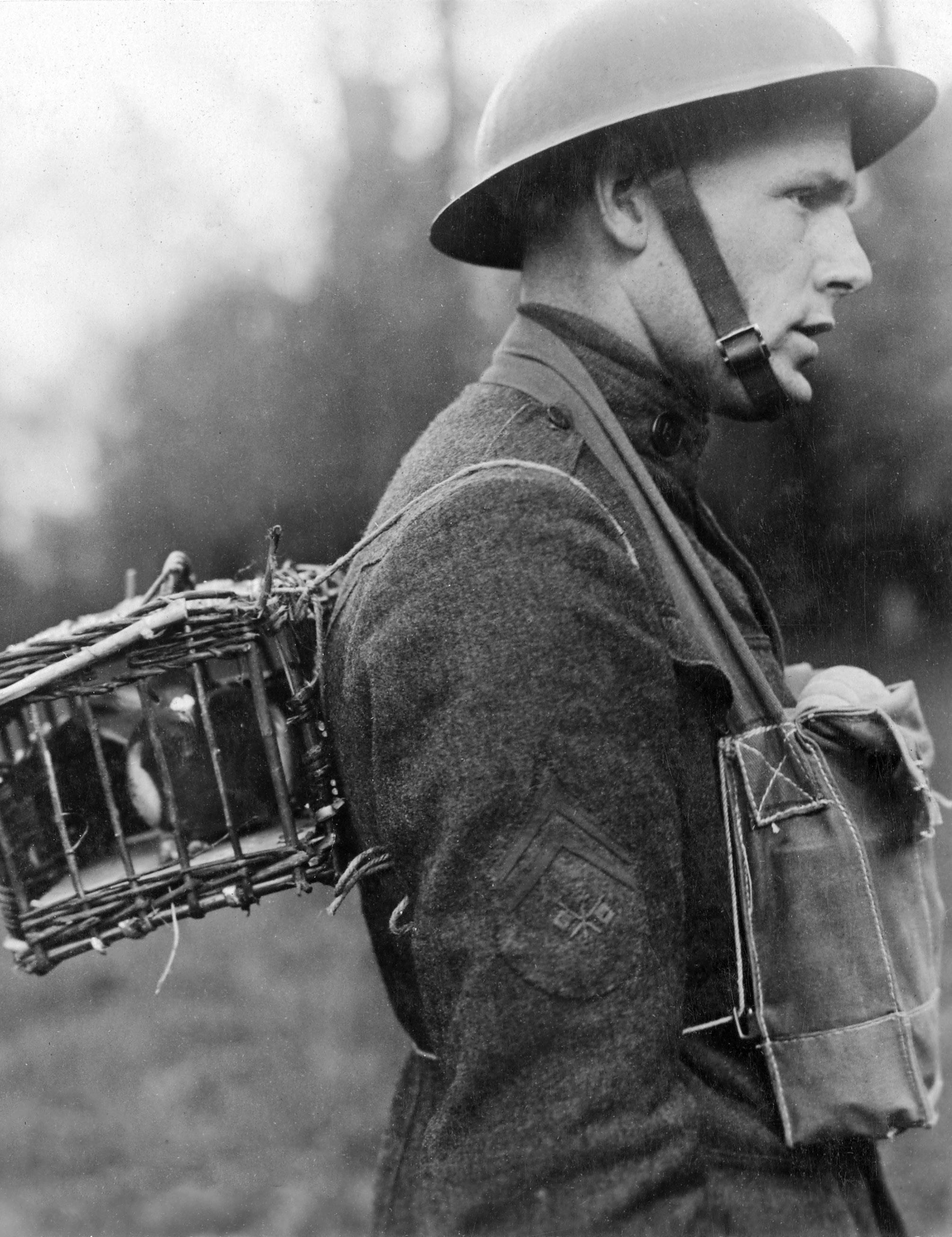
FEATHERED MESSENGERS
U.S. Army Signal Corps Pigeon Service in World War I, 1917–18
by Frank A. Blazich, Jr.
In October 1918, an American infantry division found its flank threatened by a German counterattack. The division commander wished to coordinate his movements with the corps commander, but the telephone lines were down. Annoyed, without his phone, and disinclined to use the functional radio, the division commander instead called for a homing pigeon. Lacking any birds, the general’s aide located a nearby
signalman and requested a pigeon. The young enlisted man, a recruit telephone lineman, had no idea why the general wanted a pigeon. Not wishing to disappoint his commander, the young man went to a sergeant who had a pet pigeon, borrowed the bird, and presented it to the aide. Pigeon in hand, the aide raced back to the division headquarters. A message was prepared and secured to the pigeon’s leg. The bird was released into the air, but it
A soldier displays how birds are to be carried into battle at the II Corps Signal School, Chatilion Sur Seine, France. National Archives photo.
17
MARSHALL’S WORLD
Middle:
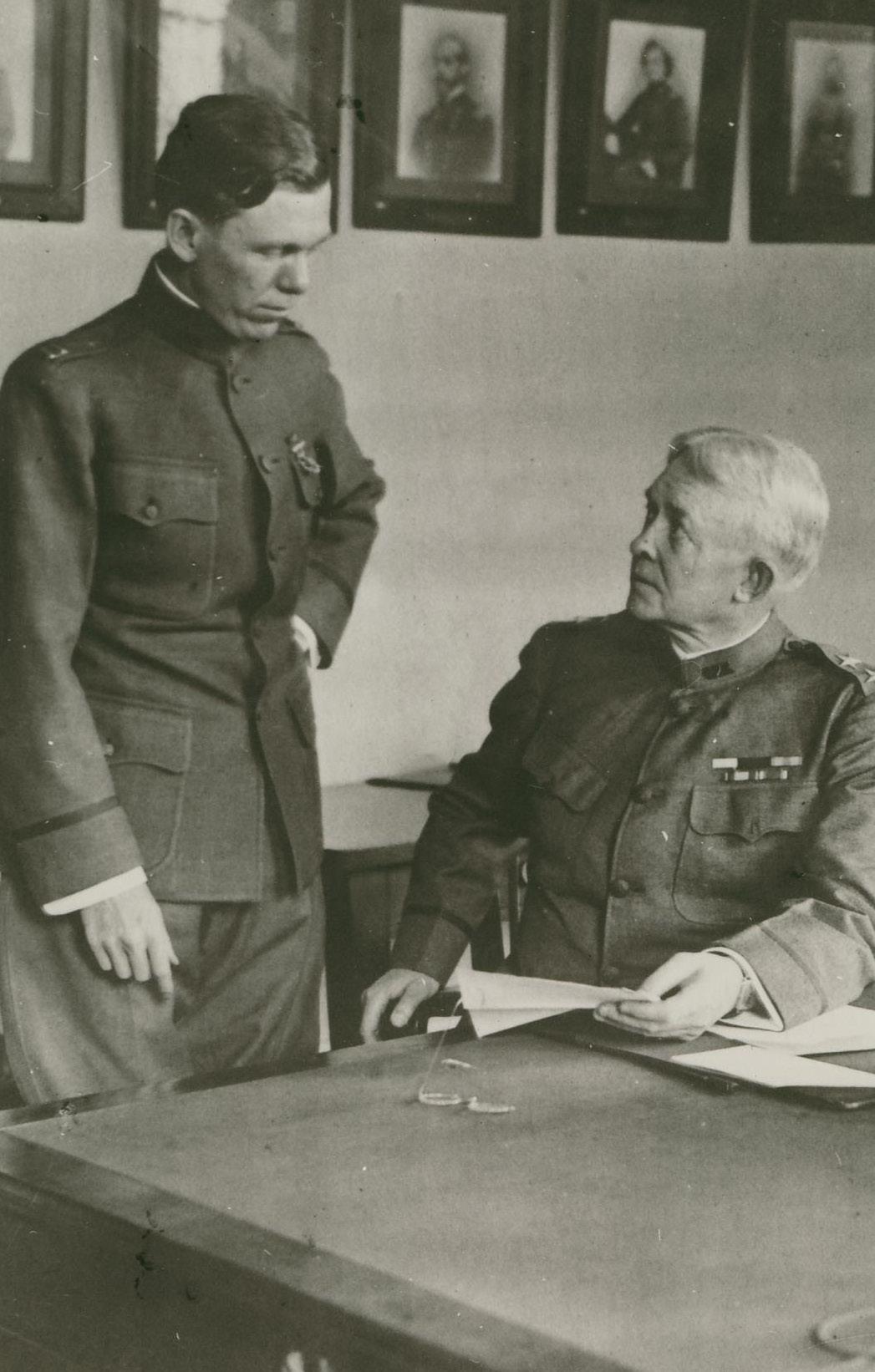
landed immediately and proceeded to peck at the message tube.
“What is the matter with the damned pigeon?” asked the chief of staff.
“Where is the signal officer?” demanded the general.
At this point, the pigeon’s owner happened upon the scene and asked for his pet back.
“Take him, he is no good to me,” grumbled the general, but word that the corps commander was on the telephone soon smoothed his ruffled feathers.
After this incident, the division headquarters received a steady supply of trained homing pigeons.
By contrast, Col. George C. Marshall, an operational planner in the headquarters of the American Expeditionary Forces (AEF), had firsthand knowledge of the value of the pigeon messengers. Earlier in 1918 during the Battle of Cantigny, German artillery shredded the American wired communications. Pigeon messages, however, managed to reach 1st
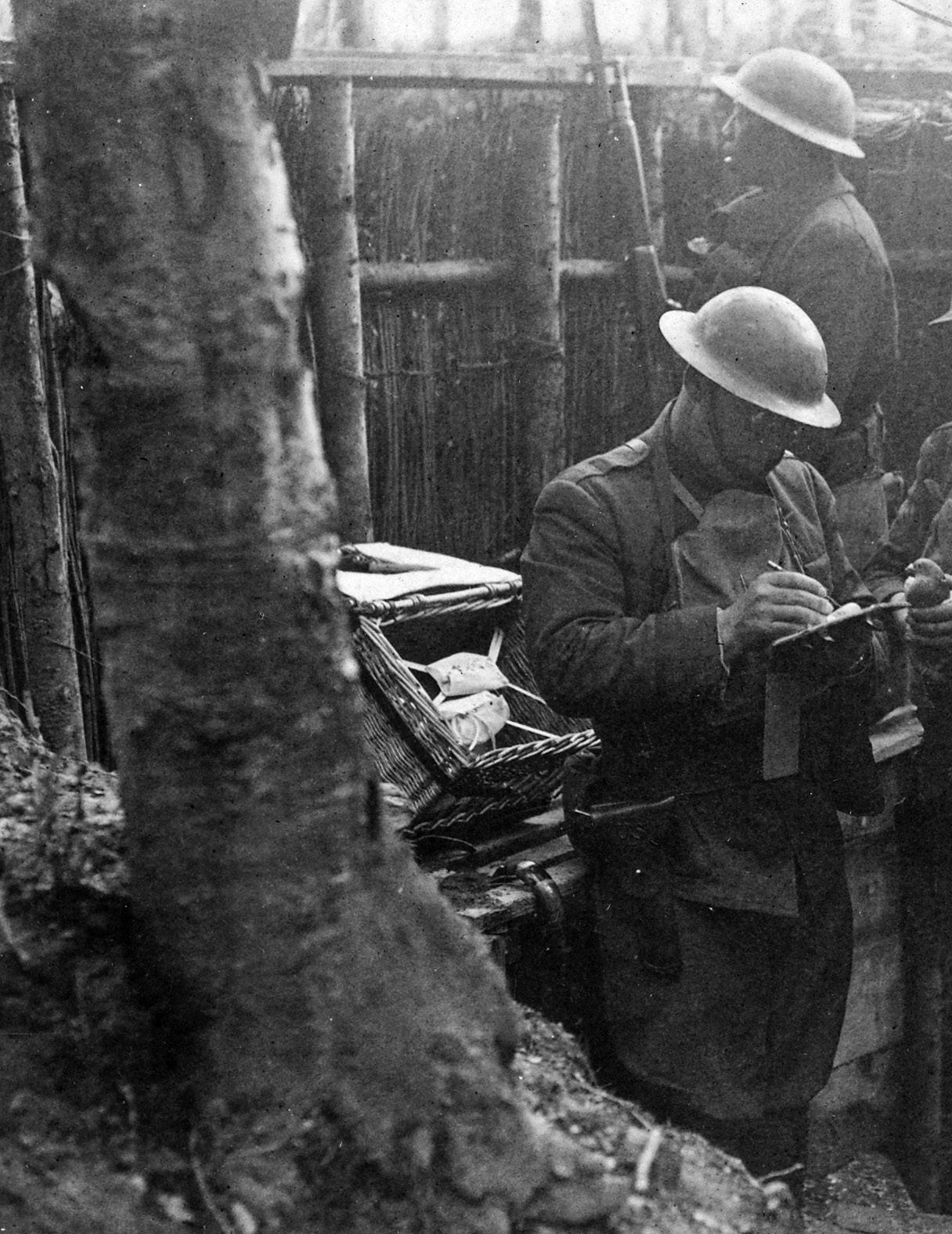
Division headquarters and provided clarity on the battlefield situation. While preparing for the grand assault on Sedan in late October, Colonel Marshall called several young officers into his office. He ordered each of them over to the chief signal officer to receive training in the handling and use of homing pigeons. Upon their return, Marshall issued the men instructions to accompany the assault troops of the attacking divisions. Equipped with six pigeons apiece, the officers would release four messages on November 1 and two on November 2 at designated hours, providing the exact point which the lead troops of each division had reached. Through this technique, recalled Marshall, “we thus had an accurate statement of the location of the most advanced troops of the Seventy-seventh, Eightieth, Second, Eighty-ninth, and Fifth divisions at the same hour.”
These markedly different anecdotes show that the familiarity of the U.S. Army with the use of homing pigeons as an auxiliary
18
Left: Capt. George Marshall as aidede-camp to Maj. Gen. J. Franklin Bell, 1917.
Soldiers from the 42nd Division prepare pigeons to carry messages back from the front. National Archives photo. Right: Col. George Marshall in Chaumont, France, 1919.
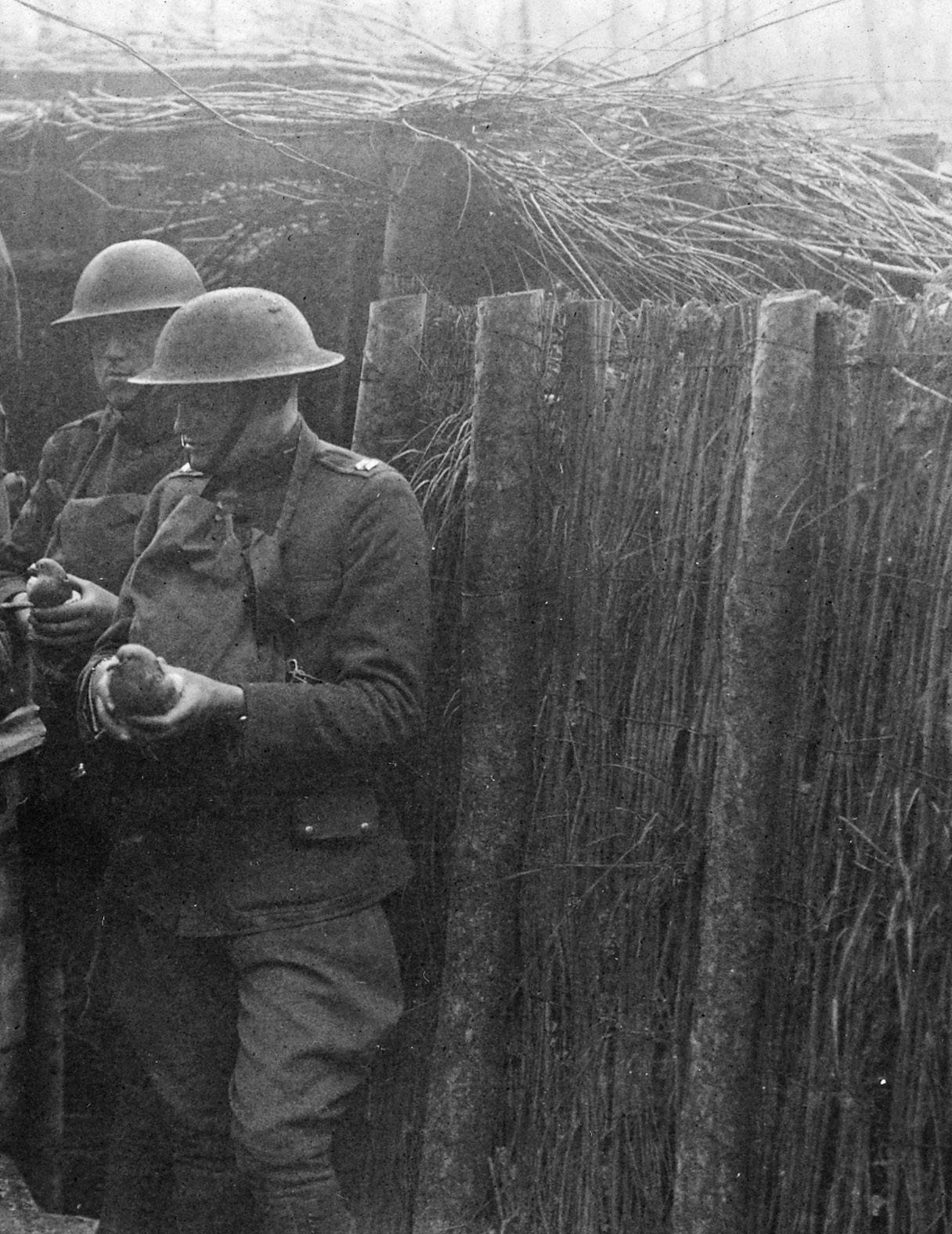
method of communication was not widespread in World War I, even though homing pigeons proved reliable messengers on the battlefield. For the U.S. Army, the Signal Corps’ Pigeon Service experience offers a unique case study in civil-military relations and the rapid adoption of coalition knowledge and technology.
OLD “TECHNOLOGY” FOR A NEW ERA OF WARFARE
After the United States entered the war in April 1917, senior military leaders confronted unfamiliar weapons, technologies, and stratagems. The years of fighting since 1914 had already demonstrated to European combatants that scientific and technological development combined with new means of industrial output proved exceptionally lethal. These new technologies, however, remained foreign to American military members. Despite the threat of German submarines to safe passage

at sea since 1914—as demonstrated by the sinking of civilian vessels, such as the RMS Lusitania, by German U boats—the U.S. Navy had limited knowledge of recent advances in submarine warfare. Almost no American sailor had ever seen or heard of a depth charge, a recent but widely employed innovation, until May 1917. On land, the defensive advantages of trench warfare forced combatants to seek new technologies to either better protect or dislodge soldiers. The introduction of poison gas resulted in the extensive production and use of gas masks. Concentrated use of shrapnel and canister shellfire reintroduced widespread use of combat helmets to protect against lethal head wounds. When the first members of the AEF arrived in France in late June 1917, however, they marched ashore sporting felt campaign hats reminiscent of cavalry actions in the American West. American doughboys soon adopted steel combat helmets, copied from a British design. As it entered the trenches, the AEF faced a steep tactical learning curve that
19
would force officers and enlisted men alike to draw heavily on their allies’ experiences in this new world war.
Despite its relative inexperience with contemporary military innovations, the U.S. Army entered the war with notable advantages in communications technology. The Signal Corps led the world in military telephony and expertise, but this wire-reliant equipment proved vulnerable to outages or interception in a war with frequent massed artillery fires.
Col. Edgar A. Russel, General John J. Pershing’s chief signal officer for the AEF, spent his first weeks in Europe meeting with his British and French counterparts. He soon learned about the use of a relatively simple communications method: homing pigeons. French officials championed the value of homing pigeons after their performance at Verdun. In a report
provided to Colonel Russel and the AEF, the French experience demonstrated that:
Pigeons only, can work regularly, and in spite of bombardments, dust, smoke or fog, can bring accurate details concerning the situation of the troops in action within a relatively short space of time. Liaison by pigeons has rendered inestimable services ever since the beginning of the battle of Verdun. It has won the approbation of the high command and line officers, and its general adoption is advisable.
For the British Expeditionary Force, “the necessity and possibility of maintaining liaison
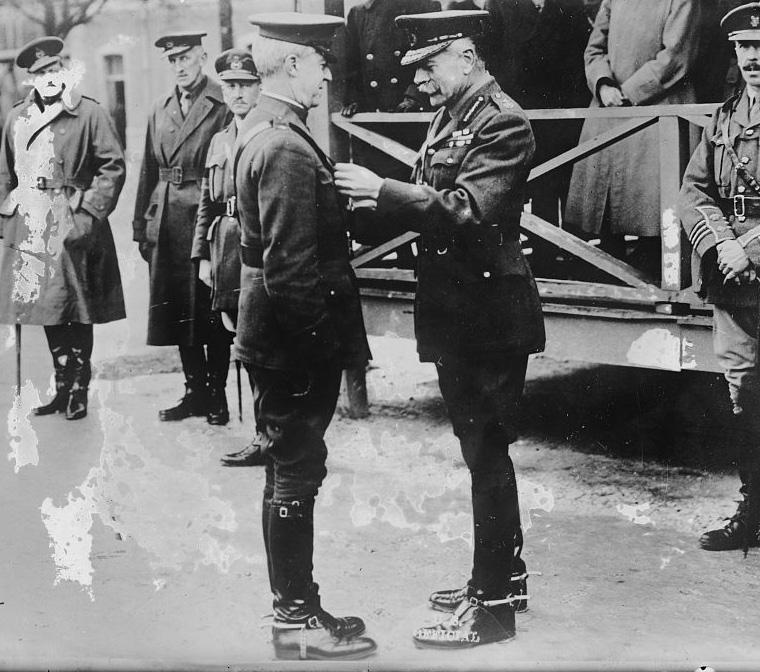
20
Edgar A. Russel, shown here as a brigadier general, being decorated by Field Marshal Douglas Haig. National Archives photo.
by means of pigeons, has been demonstrated during the battle of Verdun and confirmed during the offensive on the Somme. This method of liaison has always been able to operate regularly. In many cases it was the only one which was able to resist the weather and the means of destruction of the enemy.”
The weight of evidence proved sufficient for Russel to act. On July 16, 1917, he wrote to Maj. Gen. George O. Squier, chief signal officer of the U.S. Army, about his staff’s investigations into French and British pigeon usage. Russel concluded that “[t]here is no longer any doubt of the immense importance of this service, and the necessity of the immediate action of the United States to provide similar service for our armies.” The following day, General Pershing wired Squier requesting the swift commissioning of two pigeon specialists as
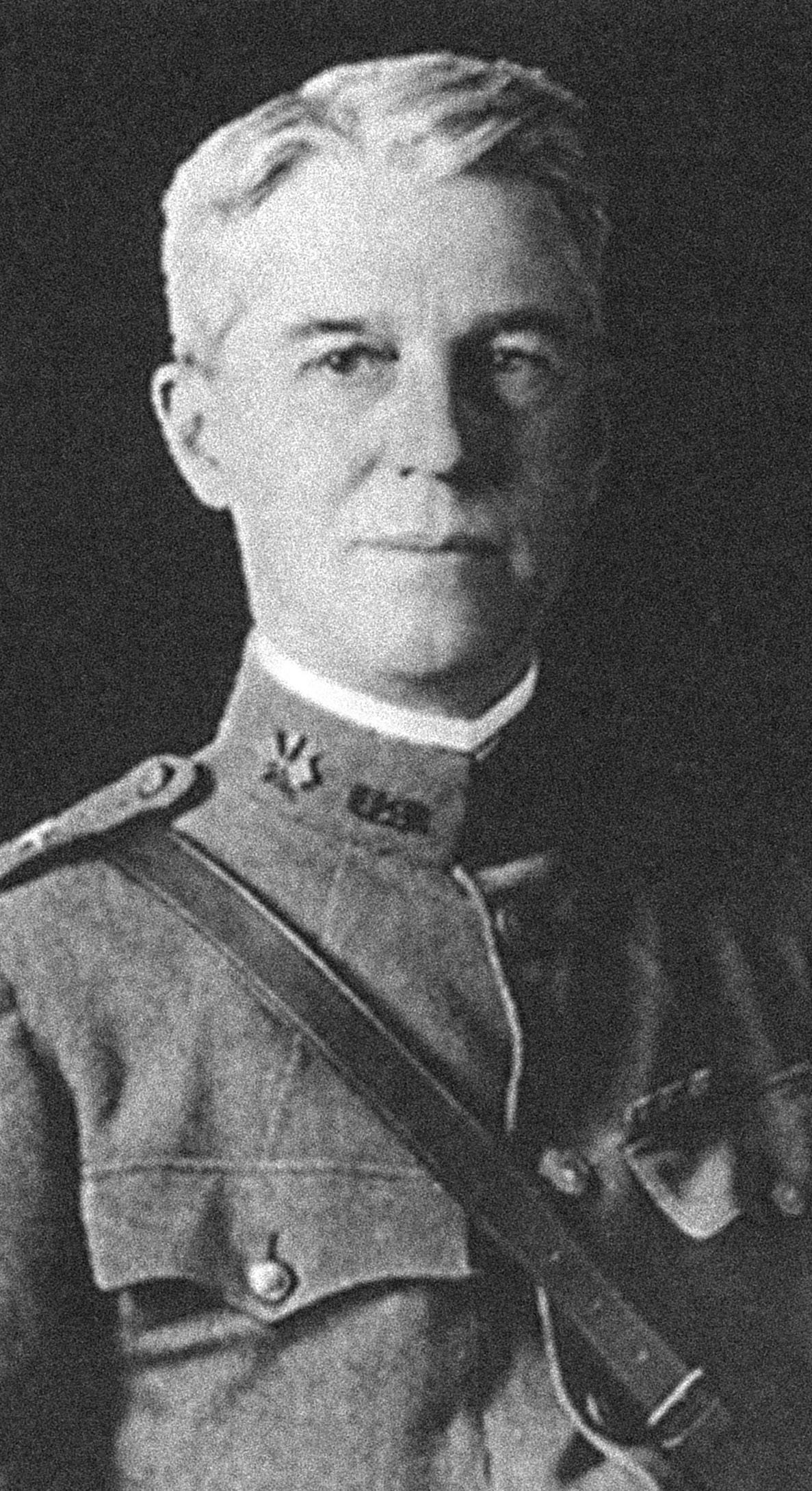
first lieutenants to accompany twelve enlisted pigeon experts for service in France.
PIGEONS IN THE PREWAR U.S. ARMY
For millennia, both in times of war and peace, humans have recognized and used the homing ability of pigeons for the transportation of messages. The U.S. Army began working with homing pigeons in the Dakota Territory approximately forty years before World War I. In 1878, the Signal Corps purchased a dozen pigeons from Thomas Gist of Philadelphia and shipped the birds out west to Col. Nelson A. Miles commanding the 5th Infantry Regiment at Fort Keogh in Montana. These birds bred and increased to number around fifty. Hawks killed some of the pigeons in the course of
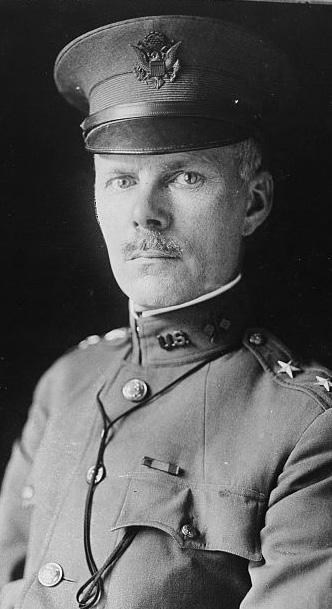
21
Left: Brig. Gen. Edgar A. Russel
Right: Maj. Gen. George O. Squier

Miles’s experiments, but he still managed flights of about one hundred miles from the mouth of the Bighorn River back to the fort. Despite limited time and undertrained birds, Miles deemed his pigeon experiments successful, having demonstrated “the fact that they can be made useful for military service.” Four years after Miles’s experiment, Signal Corps 1st Lt. William E. Birkhimer questioned the present utility of homing pigeons and the need to develop a detail plan for a military pigeon service. In 1888, the Signal Corps established a small pigeon loft at Key West, Florida, but closed the operation four years later, transferring the birds to the U.S. Naval Academy. In the 1890s, the navy saw value in using homing pigeons for ship-to-shore communication and managed to attract congressional attention to the birds’ potential uses. A legislative proposal was introduced in Congress in 1898 by Senator Jacob H. Gallinger to establish a homing
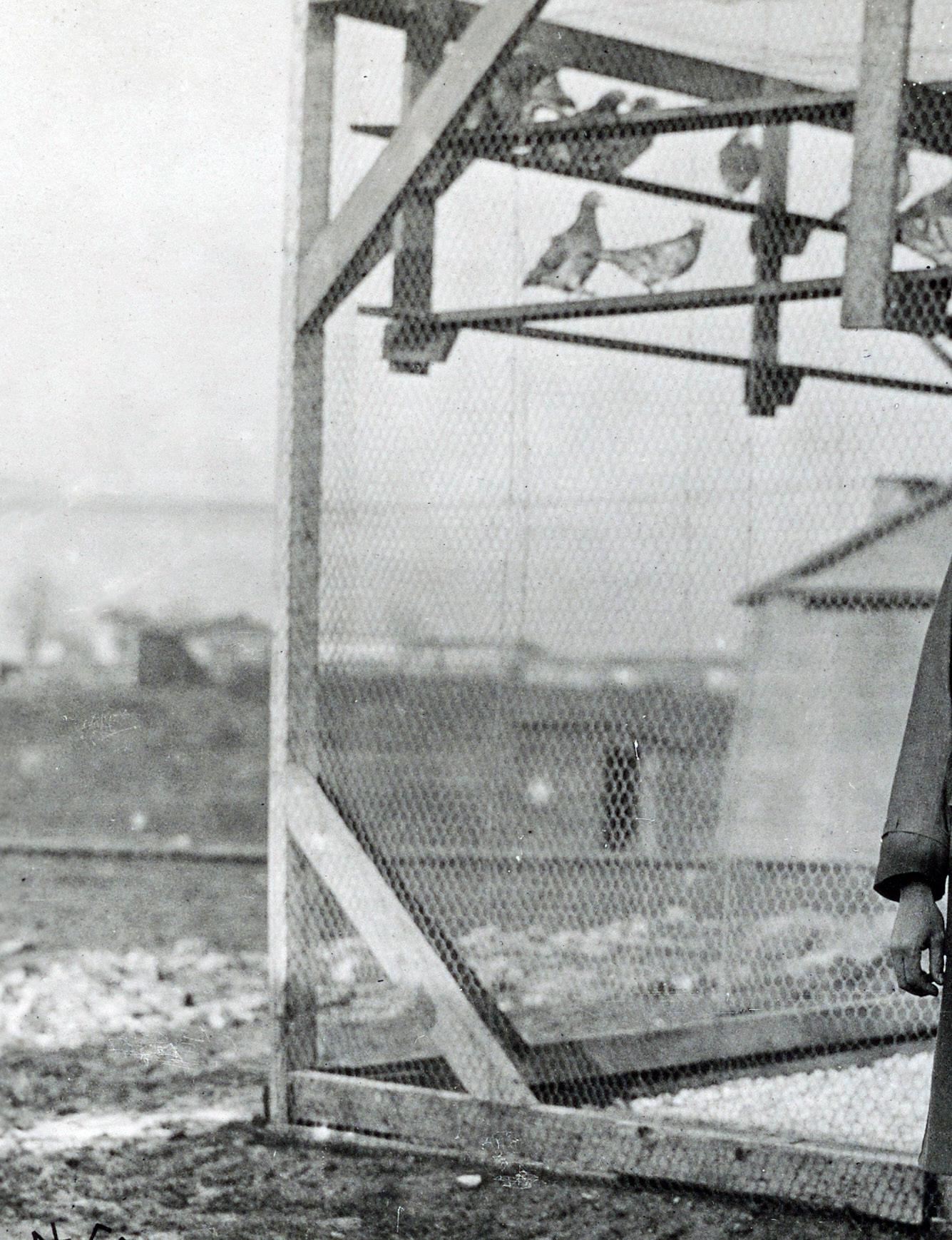
pigeon service in the Treasury Department for commercial, military, and naval purposes. The bill died in committee.
Despite the army’s initial disinterest in the concept, civilian homing pigeon enthusiasts promoted the uses of pigeons for military purposes in the ensuing years. Pigeon racing itself came to the United States in the 1860s, and the first organized pigeon racing efforts began in the early 1880s. In 1910, the pigeon racing community reached consensus on racing rules and standards, and the American Racing Pigeon Union (AU) launched in Washington, D.C., on August 15, 1910. Under the AU, pigeon racing clubs from across the nation could compete on equal terms in races of varying distances and for ever-increasing prizes. On the eve of America’s entry into World War I, the Signal Corps experimented with homing pigeons in Mexico as part of Pershing’s Punitive Expedition of 1916, but the trials were unsuc-
22
Left: Racing pigeon
Middle: Captain Buscall in front of a pigeon loft at Langres, France. National Archives photo. Right: Captain John L. Carney. National Archives photo.

cessful. They found fault with inexperienced personnel and pigeons that had not acclimated sufficiently to the environment.
FINDING THE RIGHT PIGEONEERS
By late summer 1917, the War Department had located two men who shared the essential qualifications for the new pigeon service: prior military service and pigeon-racing experience. The man destined to lead the AEF pigeon effort worked at the Marine Barracks in Washington, D.C. English-born David C. Buscall arrived in the United States in 1890 and settled with his family in Springfield, Massachusetts. He had developed a fondness for pigeons as a child in London, and frequently built his bird lofts on the roof of his father’s or neighbors’ houses. Enlisting in the U.S. Marine Corps on September 2, 1905, Buscall was

serving as a quartermaster sergeant by June 1917. Discharged from the Marine Corps on August 23, he commissioned the next day as a first lieutenant in the U.S. Army Signal Corps. John L. Carney of Pittsburgh joined Buscall on September 4. A native of Salem, New Jersey, Carney was a veteran Signal Corps telegrapher, having seen service in the Spanish-American War, the Philippine-American War, the Boxer Rebellion, and at the Mexican border during the Punitive Expedition. Like Buscall, he had bred and worked with pigeons all his life. Both men were founding members and officers of the AU, with Carney having served as its second president from 1913 to 1914.
Together, the men began assembling a pigeon service for the U.S. Army. Throughout September 1917, they used their connections in the racing pigeon community to purchase birds, pigeon feed, and locate additional personnel to fill out the enlisted ranks of men—to
23
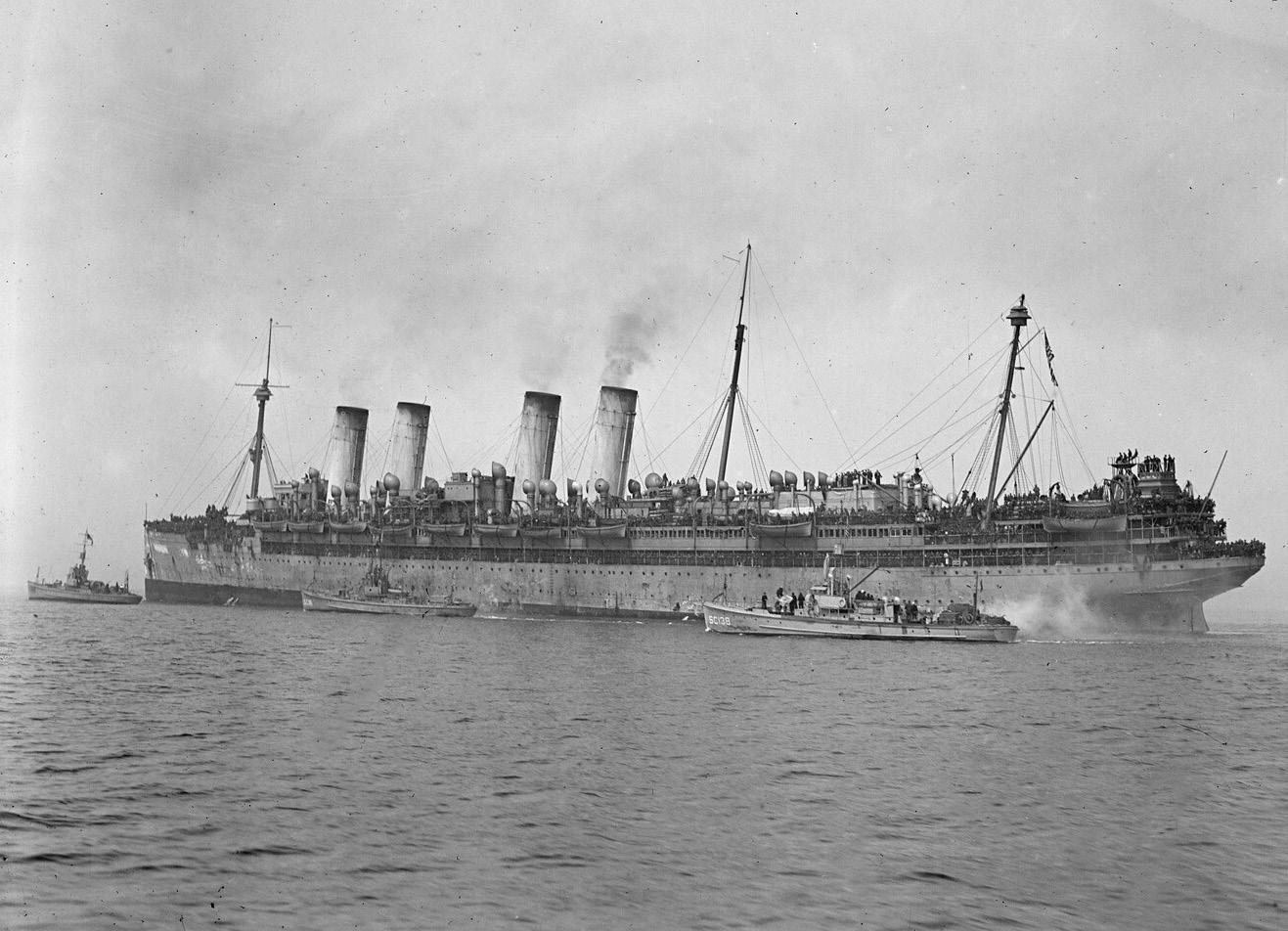
be known as “pigeoneers”—for the U.S. Pigeon Intelligence Service. Buscall arranged with the carriage-building firm of Sechler & Company of Cincinnati, Ohio, for the purchase of twelve mobile pigeon lofts of his own design to be shipped along with the birds. By October, a blend of purchases and patriotic donations fielded a feathered army force of approximately 2,350 young and breeding pigeons. The birds were shipped to holding lofts at Fort Wood, New Jersey. By October 13, the Signal Corps requested overseas orders for half of the initial personnel requested by AEF General Headquarters. On October 29, Buscall, along with 6 noncommissioned officers, 800 pigeons, 12 mobile lofts, and a supply of feed, boarded the transport USS Agamemnon bound for France. Arriving in Brest on November 12, the small detachment moved to Paris and quartered at the French pigeon lofts at Vaugirard.
The unit was now officially authorized and designated as the Signal Corps Pigeon Service, and the AEF General Headquarters tapped Buscall as its officer in charge. He got right to
work on two fronts: first, to secure permanent lofts for the AEF’s birds; second, to learn everything about the military training and fielding of homing pigeons. Buscall and Russel met and reached an agreement on November 20 to construct a central breeding base to supply the AEF with young birds, selecting a location near the entrance to Fort de la Bonnelle, Langres, in northeastern France for this purpose. On December 5, Buscall and four of his men left Paris and headed first to Amiens and then to the headquarters of the 13th Corps of the British Expeditionary Force near Arras. For two days, the Americans studied the British mobile lofts and at the advance trench posts that provided pigeon service in the sector immediately in front of Vimy Ridge. The American pigeoneers also visited stationary lofts at Arras and the British breeding base at Albert.
On December 10, Carney arrived at St. Nazaire aboard the USS Henry R. Mallory, along with 6 noncommissioned officers and 1,800 birds. For the voyage over, the army had stored the crates of pigeons on the hurricane
24
USS Agamemnon.
Boston Public
Library photo.
deck, covered with tarpaulins. When the transport hit rough, pitching seas, sailors worked the decks to secure the birds and keep the crates from washing overboard. After joining Buscall and his half of the pigeon detachment in Paris on December 14, the two officers traveled to Toul to meet with the pigeon officer of the French Eighth Army. Carney and Buscall inspected the French mobile lofts and stationary lofts as well as French pigeon operations in combat. Subsequently, Buscall saw to it that two samples of every article of French mobile loft equipment was collected for shipment to the United States to be reproduced for training use.
By late December, the officers had completed their initial observations, and the Pigeon Service began to take flight. The rigors of the initial overseas voyage discouraged the importation of younger birds, so the Pigeon Service would have to either breed its own birds or purchase French and British pigeons
to serve the AEF’s needs. In the meantime, the American pigeons that Buscall and Carney had brought over, the majority of which would serve as breeding birds, would have to acclimate to France. On December 31, Buscall received clearance to acquire the materials for construction of a central breeding base of his own design. His plans consisted of fifteen buildings, measuring twenty by fifty feet, subdivided into four compartments, with each building housing ninety-six breeding pairs. Delay after delay hampered the work; not until March 15, 1918, one month after initially promised, did the American birds move from the French lofts in Paris to the new quarters at Langres. The birds undoubtedly were relieved to enter their new lofts, having spent a week in shipping baskets awaiting completion of the “barracks.” Although the finished lofts differed from Buscall’s original plans, they proved successful for the AEF. On March 20, Carney took command of all breeding operations,
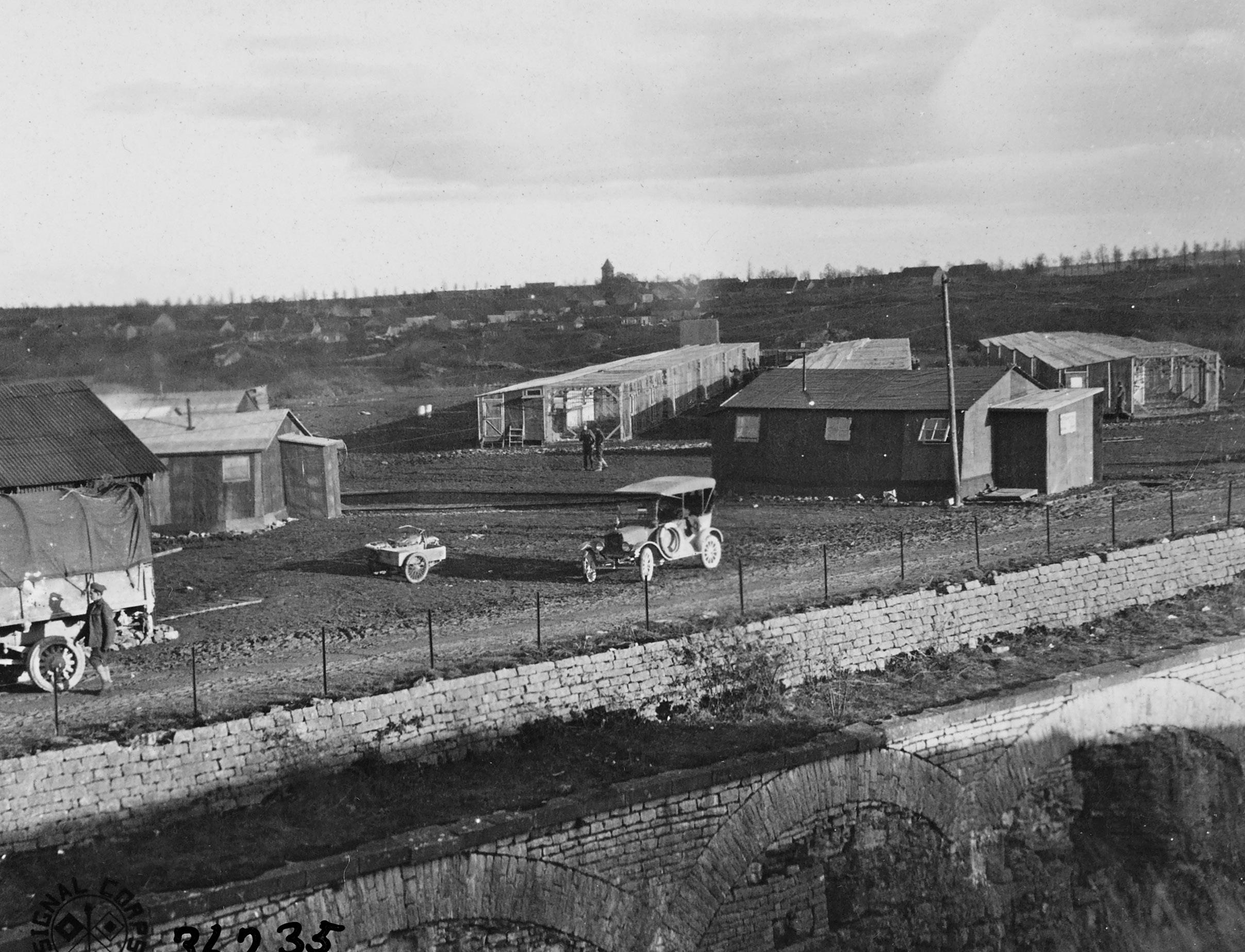
25
View of the breeding base at Langres, France. National Archives photo.
and under his care approximately 900 breeding pairs would supply Pershing’s forces with 4,422 young birds by November 1918.
Allied generosity provided additional young birds to supplement those raised by the American breeding lofts. In mid-May 1918, Maj. Alfred H. Osman, commanding the British Home Forces Pigeon Service, arranged to donate 600 young British pigeons to the AEF. On May 20, Sgt. Frederic J. Herrmann arrived at the British pigeon depot at Kings Cross, London, to assist in the selection and packing of the 600 young birds donated by British pigeon fanciers. A pigeon racer before the war, Herrmann was one of the first Signal Corps pigeoneers sent to France in early November 1917 to establish the AEF’s pigeon service; he was well qualified to select top fliers. By May 23, Herrmann and the birds, together with a supply of feed and transport baskets, arrived
in Langres. There, the Pigeon Service divided up the English birds, sending 245 to the front in mobile lofts, shipping 30 to the stationary loft at Châtillon-sur-Seine, and leaving the remainder at Fort de la Bonnelle. In ensuing months, the majority of the English birds would be moved into American mobile lofts as the AEF’s operations increased at the front.
The raising and preparing of the Pigeon Service’s new recruits seemed akin to basic training for the infantry. At approximately three weeks, attendants would remove the squeakers from their parents and move them to a weaning loft where the birds learned to feed themselves. At five weeks of age, these birds were transferred to either mobile lofts or a detaining loft. More often than not, the birds moved from the weaning loft to mobile lofts held at a reserve field at the aviation field at Vaucouleurs for training as message carriers.

26
Layout of the breeding base at Langres, France. National Archives.
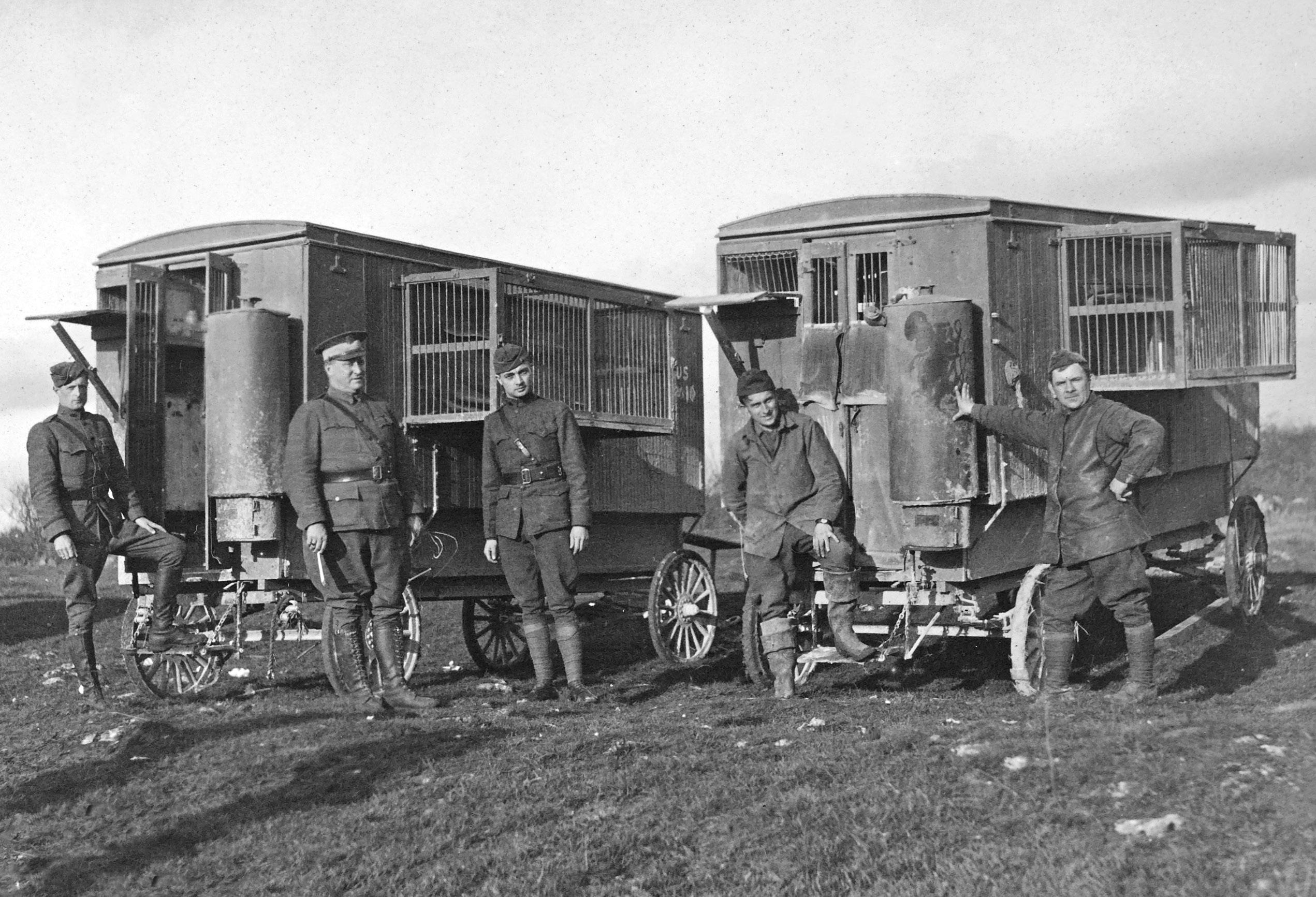
At ten weeks, the birds were ready for use in the trenches, able to execute short flights of ten or so miles to their designated lofts.
THE ARMY’S PIGEON SERVICE TAKES FLIGHT
Homing pigeons are the genetic relatives of the rock dove, Columba livia, which frequently conduct seize and hold operations or tactical air strikes on urban residents and residences worldwide. In viewing a homing pigeon as a piece of equipment or technology, the best comparison is to a thoroughbred racehorse. To quote a 1918 U.S. Army pigeon manual, the birds are “the result of several centuries of intelligent cross-breeding between various races derived from the . . . rock pigeon. This crossing, which was only made with the perfect specimens of each race, has produced an amalgam: the Homing pigeon of today, a variety of the pigeon family noted for its superior intelligence and physique.” The pigeons themselves weigh roughly a pound for each sex, and are capable of flying uninterrupted for 12 to
15 hours daily, covering 500 to 700 miles, and at speeds varying from 30 to 60 miles per hour. Contemporary champion birds can sprint at over 90 miles per hour.
As AEF breeding operations stood up, the human component of the Pigeon Service likewise began to coalesce. The initial plan for the AEF’s Pigeon Service assigned three officers and fourteen enlisted men to AEF Headquarters, one officer and eight pigeoneers for each army corps, and fourteen pigeoneers for each division. In mid-December 1917, the chief signal officer received orders for an additional two officers and ninety-six enlisted men to join the small pigeon service vanguard. This personnel would complete the headquarters for Pershing’s AEF General Headquarters and also would provide the pigeon needs of the I Army Corps and six infantry divisions. Almost immediately thereafter, the Signal Corps requested a second authorization for 10 officers and 602 enlisted soldiers for the Pigeon Service, both domestically and overseas. On January 31, 1918, just two additional officers and eighty-one enlisted personnel sailed
American-designed mobile lofts employed by the British Army. National Archives photo.
27
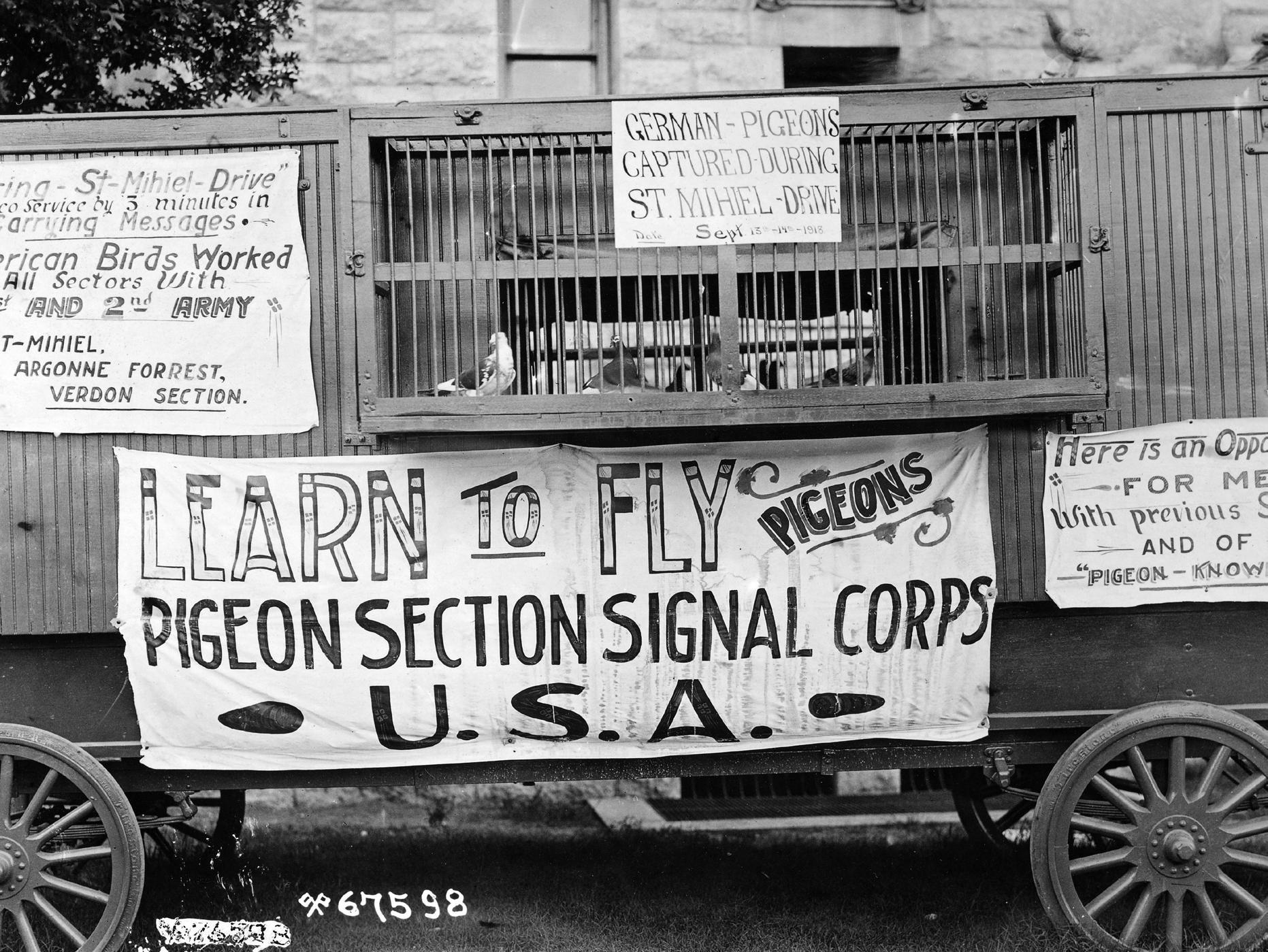
for France, comprising the last pigeon-specific personnel sent overseas during the war.
In February, with personnel limited, Buscall and other senior Signal Corps officials began work on a plan to reorganize the Pigeon Service as an army-level pigeon company. The company would maximize the use of existing personnel to support five corps, each composed of six divisions. The resulting company, Pigeon Service Company No. 1, numbered 9 officers and 324 enlisted soldiers. With personnel authorized to staff ninety mobile lofts, each army corps and division headquarters could receive lofts and pigeoneer support that could be tailored to the battlefield situation. This plan received approval in Washington on July 9, in time for the AEF’s first major engagements in the late summer.
The next matter to address was supply and equipment. Under the command of 2d Lt. John K. Shawvan of Milwaukee, the Pigeon Service Supply Depot opened on March 1 in Langres to oversee the stocks of grain and an
array of pigeon equipment required for field operations. The specialized pigeon field equipment placed into service with the American birds was predominantly French-designed. This equipment consisted of various message pads, loft cleaning tools, and baskets for transporting and holding pigeons in the trenches, aircraft, tanks, bicycles, and even inside submarines. Meanwhile, Shawvan prioritized acquiring suitable mobile lofts. The twelve American-designed mobile lofts brought over in late 1917 were assembled by February 1918. These initially were complemented by eighteen English mobile lofts, which unfortunately proved to be cheaply constructed and were deemed unsatisfactory for both birds and pigeoneers.
Mobile lofts were the critical cornerstone of AEF pigeon operations, often serving at the battlefront. Each wooden loft was mounted on what was essentially an automobile chassis with leaf-spring suspension. The loft’s interior consisted of three compartments. The first, rearmost compartment held feed bins and
28
A mobile loft, displaying captured German pigeons, is used as a recruiting station. National Archives photo.
supplies while the two forward compartments housed the birds, separated into either old and young birds, or hens and cocks. Perches and nest boxes outfitted these compartments. Nest boxes were painted in varying colors of red, white, and blue to help identify nesting birds. A large water tank was mounted on the rear of the loft for siphon-system drinking troughs, and personnel were instructed to keep the lofts clean and in good order at all times. Mobile lofts initially stored and maintained pigeon trench equipment, issuing it directly to infantry regiments until August 1918, when the AEF decided to instead issue such items directly to the infantry regiments.
The mobile lofts provided the primary training for the birds assigned to them, because they could advance along with ground forces. At all lofts, pigeons would be stamped on the fifth or sixth primary flight feathers on the right wing with the letters “U.S.” and numbers designating the bird’s assigned loft. Prior to being sent out to the field, birds were separated
by sex and marked just above the tail with blue ink for cock birds and red ink for hens. At the lofts, pigeoneers divided the birds into lots of twelve per field station, with each lot further subdivided into three sets of four. Soldiers could carry a maximum of four birds in a backpack-style infantry basket. The baskets also contained message blanks, carbon sheets, a pencil, food, message tubes, instructions, and a gas-proof cover. Two-bird baskets were also available for use, albeit designated for assault infantry, aviation units, or the tanks corps.
To prepare the AEF’s doughboys for this new battlefield resource, the Pigeon Service established a detailed training effort. A fixed instruction loft was erected at Gondrecourt in mid-May and stocked with forty pigeons on June 3. American Pigeon Service personnel attended French and British training courses and then returned to teach AEF personnel assigned to the French and British sectors of the Western Front. The AEF five-day course to train auxiliary pigeoneers covered such topics
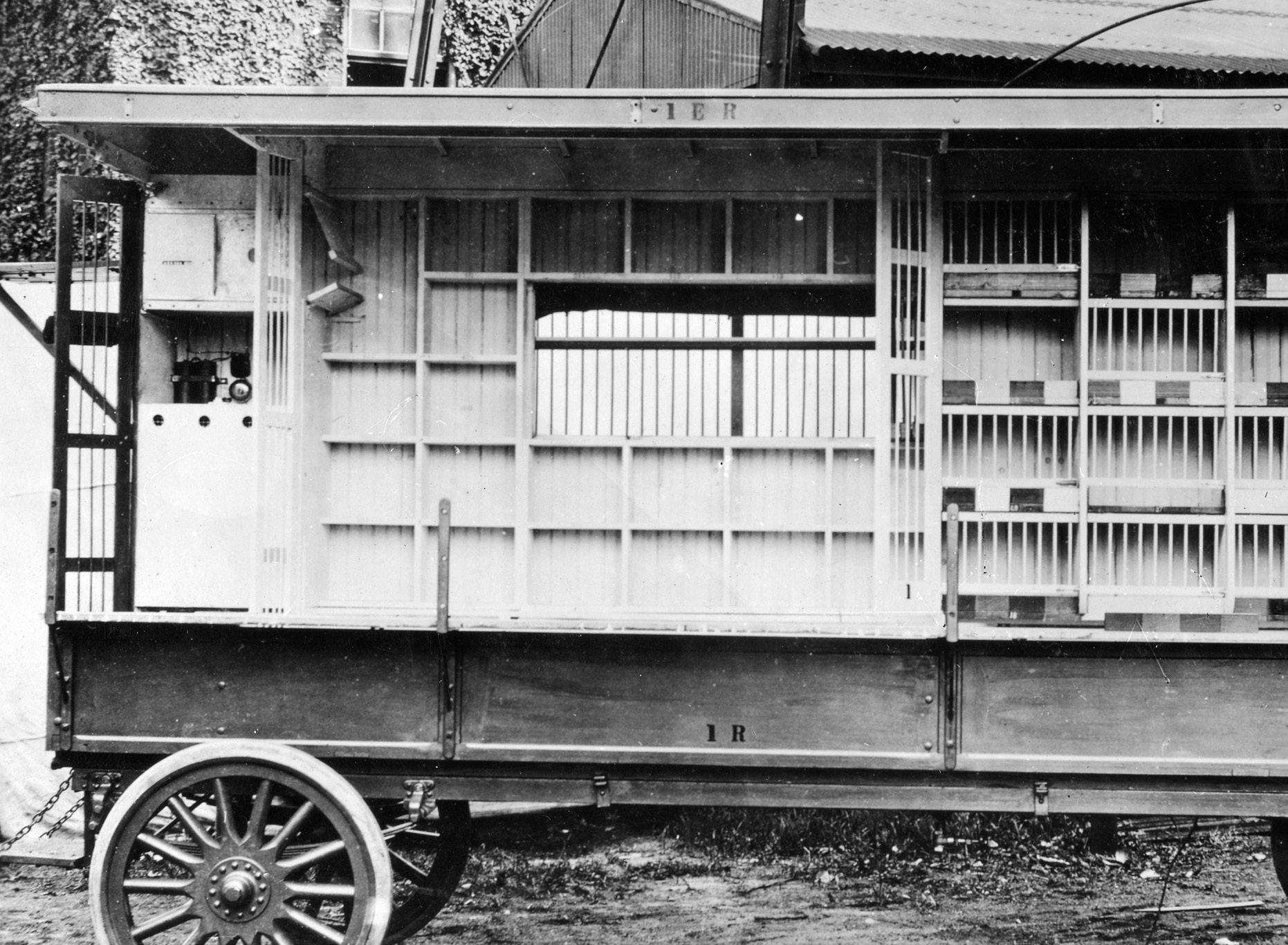
29
Interior of a mobile loft. National Archives photo.

as the characteristics and proper handling of homing pigeons, writing and attaching messages, feeding and watering, and the use of various kinds of pigeon equipment. Students learned that the purpose of the birds is “to insure a quick liaison when other methods of liaison are too slow, unreliable or when they have broken down between the first line troops and the command.”
Restricting the pigeons’ food was arguably the most important concept for students to grasp. The primary method for training pigeons to home is to teach the birds that the loft is where food and mates are located. Soldiers were thus ordered not to feed pigeons in the field until they had been away from the loft for twenty-four hours, and then only with the food provided. As one lecturer explained, “The object in keeping the birds hunger during the day is to insure their quick entry into the loft in the event of their being liberated with a message.” After forty-eight hours of confinement, however, the bird’s physical condition deteriorates, thereby limiting its speed and potential
desire to return to the home loft and making it more likely to seek a closer source of food or avian companionship. Outside of the training loft, individual mobile and stationary lofts also provided training in the field, with the added benefit of better familiarizing the pigeoneers at the lofts with the doughboys at the front.
Pigeons would be used only when all other communication options had failed or were likely to fail. Once ferried by motorcycle dispatch to front-line troops, doughboys were instructed not to hold birds in the baskets for more than forty-eight hours. If a bird was required, the pigeongram would be concisely written in triplicate on thin tissue paper—one copy remained in the message book and one for the pigeon’s message tube, with an additional copy sent by a second bird as a backup for the original. Once the message was ready, it would be inserted into an aluminum message holder, which had metal clips that could be folded around the bird’s leg. After the pigeon entered the trap back at its loft, a handler would retrieve the message from the holder
30
Signal Corps carrier pigeon message book with carrying tubes. National Archives photo.
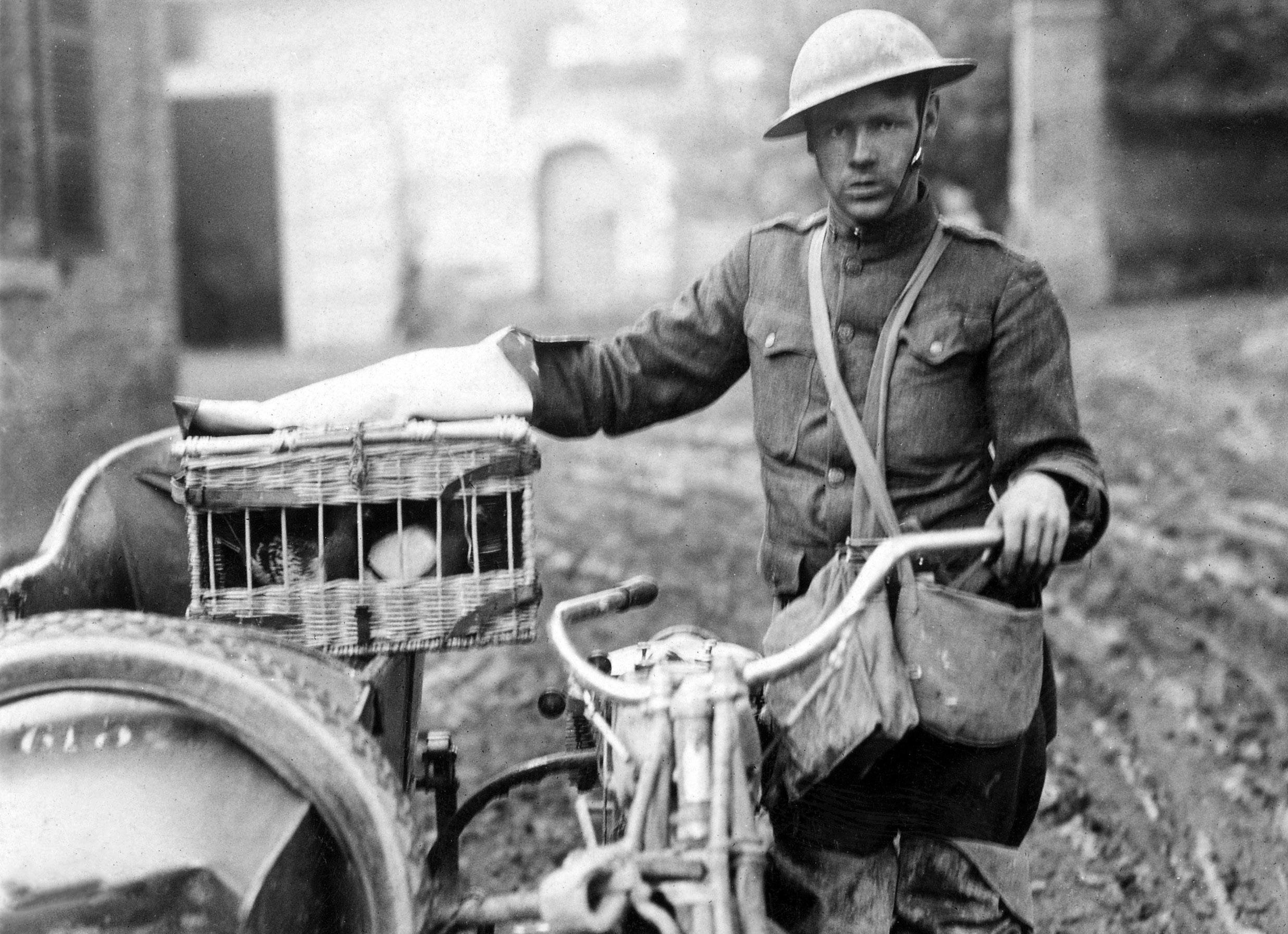
and relay its contents by telephone or courier to the appropriate headquarters.
The first field work for the Pigeon Service commenced in late January 1918. Initially, a French stationary loft at Corniéville supplied the U.S. 1st Division with French birds from the 2nd Colonial Corps of the 1st French Army, before the American pigeoneers formally assumed loft operations on January 30. Weeks later, Mobile Loft No. 1, carrying sixty American pigeons in the charge of Sgt. Henry J. Knoerschild of Buffalo, New York, arrived at the 1st Division headquarters at Ménil-laTour on February 22. To the amazement of the French, Knoerschild soon had fifty-seven of his birds homing to the loft on the French front. The first American pigeons to enter action, however, were housed at the French stationary loft at Corniéville. Those pigeons, under the training of Sgt. Lewis Swanker of Lakewood, Ohio, entered the front lines at three trench posts with stations of four pigeons each. Two days later on March 17, “Gunpowder,” a black check hen bred by Herman Moser of Aurora,
Illinois, delivered the first American pigeon message from the trenches of the front to the headquarters of the 26th Division at Boucq. Gunpowder was followed by a second pigeon, the black pied hen “Pretty Baby,” carrying a carbon copy to ensure delivery in case the first bird went down. Thus, the American Pigeon Service entered the war. By the end of April, the AEF had fielded ten mobile lofts and one stationary loft, with 652 pigeons and available resources for a further twenty mobile lofts.
Within two months, this force had more than doubled. In July, the Pigeon Service numbered twenty-two mobile and five stationary lofts, fielding 1,635 birds. Buscall, in preparation for fighting in 1919, placed orders for 150 additional mobile lofts and 30 smaller portable lofts sufficient to equip 80 divisions. Buscall also needed more pigeoneers to manage the lofts, but he found that qualified personnel were in short supply. He wrote to Russel that the necessity for such “first class pigeon men cannot be too strongly emphasized. To successfully run the service it is necessary
31
A motorcycle dispatch rider transports pigeons to the front. National Archives photo.
to have only men who are experienced and successful racing pigeon fanciers.” When American forces joined with French and Belgian troops fighting at Château-Thierry in June and July, the Pigeon Service received orders to move eight mobile lofts to the Aisne-Marne Sector for liaison duty. American pigeons soon found their way to the doughboys at the front and suffered their first combat deaths from poison gas. Despite the losses, these initial operations proved successful. From August 29 to September 11, Mobile Loft No. 9 operated at the front, where it received 78 important messages and 148 test messages from its 72 birds, none of which failed to home.
work with birds had thorough instruction in the proper treatment of homing pigeons.

Lessons from Château-Thierry and additional field training in August brought renewed emphasis on the proper use and care of pigeons as nonexpendable assets. On August 6, Buscall issued guidance to all noncommissioned officers in charge of mobile or stationary lofts that, in the event they had to abandon the lofts, the men were to save as many pigeons as they were able to carry. Lamentably, the initial field operations in July and August resulted in higher than anticipated losses of birds, often caused by improper handling. Unfamiliar with the special handling requirements, some soldiers treated pigeons as common equipment with a total disregard for the birds’ health. Many birds were abandoned in the field; others suffered from muddy or broken feathers. These losses brought a stern rebuke to all I Army Corps division commanders from its chief of staff, Brig. Gen. Malin Craig. He remarked how the recent mistreatment of the pigeons resulted in a “greatly reduced number of birds assigned” for use in each division. He thereafter instructed all division commanders to make sure that auxiliary pigeoneers assigned to
The need for pigeon service increased in mid-September with the Battle of St. Mihiel and the first massed combat use of AEF pigeons. Prior to the battle, the AEF Tank Corps’s 344th and 345th battalions, under the command of Lt. Col. George S. Patton, Jr., had trained with pigeons in simulated maneuvers and had decided to carry the birds into battle. When the attacks commenced on September 12, a total of 586 pigeons went into battle, 384 on the backs of doughboys in the trenches and 202 inside American tanks. Heavy mist and rain, together with muddy conditions in the trenches, hampered the birds’ work, but most averaged respectable thirty-minute flights at speeds of approximately 37 miles per hour. One pigeon liberated from a tank at 0800 arrived back at its loft at 0820, and the message reached the IV Army Corps’ chief signal officer by 0825. A total of sixty-four birds died in the operation, twenty-four of which were from the tank corps; their deaths primarily were the result of poor handling. Despite these losses, the surviving tanker birds safely delivered ninety important messages, resulting in an overall return rate of approximately 91 percent for the deployed pigeon force. Quite a few hero pigeons emerged from St. Mihiel, notably the American-bred birds “President Wilson” and “Lord Adelaide.” Even birds that were wounded in the action, such as “The Mocker,” who lost an eye, and “The Poilu,” who suffered severe head lacerations, successfully delivered their respective messages.
No sooner had the fighting started to subside when word reached the Pigeon Service on September 21 to prepare for an even larger operation. The Meuse-Argonne Offensive would become the bloodiest battle in American military history and would be the culminating operation for the AEF’s pigeons. Despite having only five days to reposition mobile lofts and train the birds to home, the Pigeon Service managed to place 14 mobile lofts and 442 pigeons with the U.S. First Army for the opening
32
Scan the QR code to view the Legacy Lecture on the Marshall Foundation YouTube channel:
stamps on a pigeon’s wing.
Identification
National Archives photo.
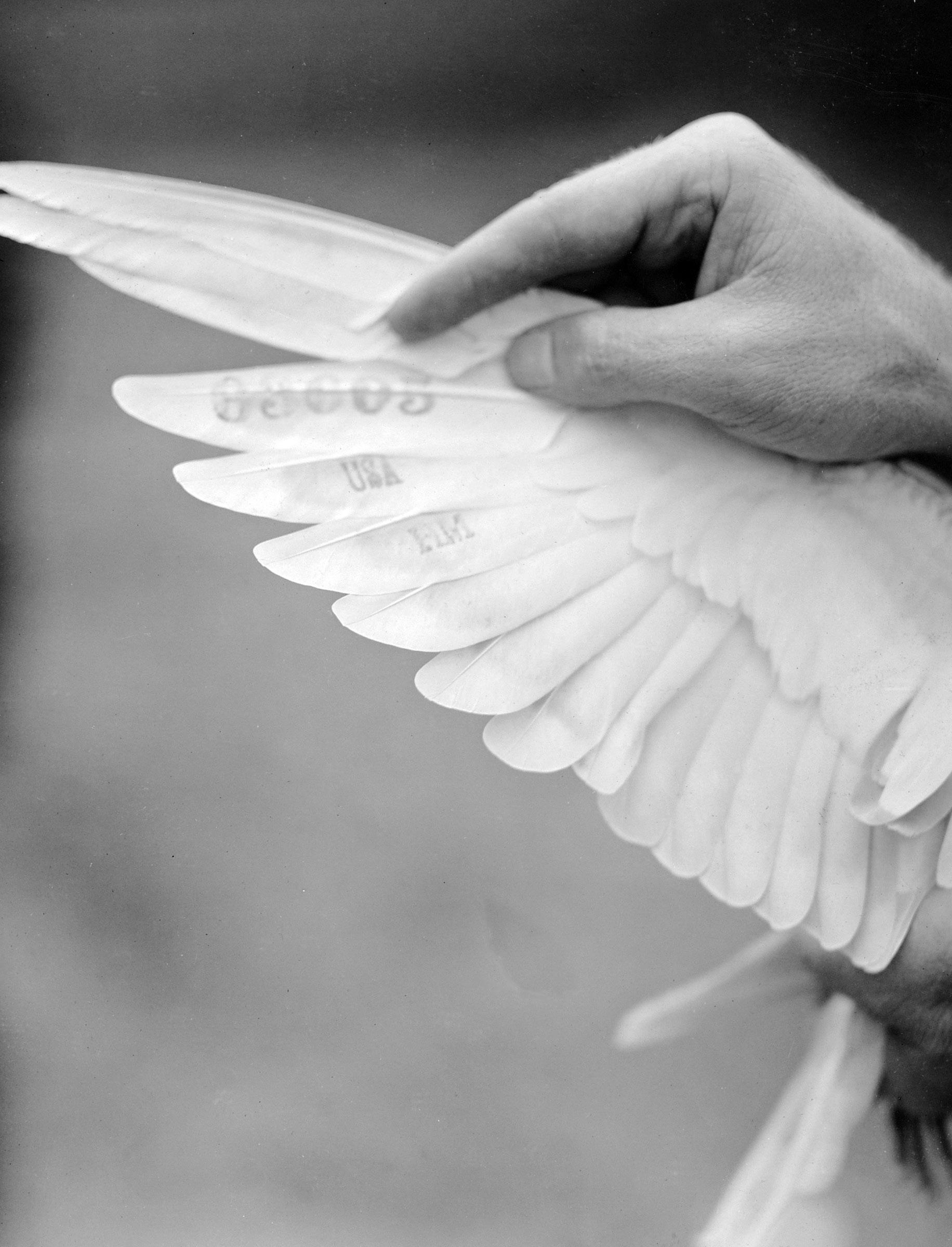
of battle on September 26. On the eve of the offensive, six out of eight French lofts that had been promised to the American forces failed to materialize; only one mobile and one stationary loft provided partial compensation. These reductions forced 90 percent of the American pigeons to be at the front, leaving little time for the birds to rest at the loft before being sent back out. French pigeons from the two French lofts joined with the American birds, although some American command posts were left underequipped because French restrictions permitted only 30 percent of their birds to go to the front at any one time.
From September 26 to the armistice of November 11, the Pigeon Service faithfully provided communications to AEF forces in the field. Pigeons who were veterans of the fighting in Aisne-Marne and at St. Mihiel served again in the Meuse-Argonne. French and American lofts received 343 important messages from the field and a further 144 test messages from pigeons released at distances from five to twenty-five miles. Buscall estimated that some birds flew at speeds averaging 31 miles per hour in
the face of severe and unfavorable weather. Buscall and his staff never compiled an official record of losses, but no pigeon carrying an important message is known to have gone astray during the offensive. Postwar, the Signal Corps estimated that no more than 10 percent of the AEF pigeons failed to return to their lofts.
The most prominent use of pigeons in the Meuse-Argonne involved the men of the 77th Division’s 308th Infantry Regiment. Under the command of Maj. Charles W. Whittlesey and accompanied by two companies from the 306th Machine Gun Battalion, the force advanced into the Argonne Forest with the objective of reaching the La Viergette–Moulin de Charlevaux–Binarville Road. Reaching the road on the afternoon of October 2, Whittlesey’s forces dug in to await further orders. Isolated from their flanking divisions, the men soon found themselves cut off by German forces, squeezed into a small pocket along the slope of the roadway, and able to communicate only through homing pigeons. Of the eight birds brought into the forest, seven successfully delivered messages from the stranded troops
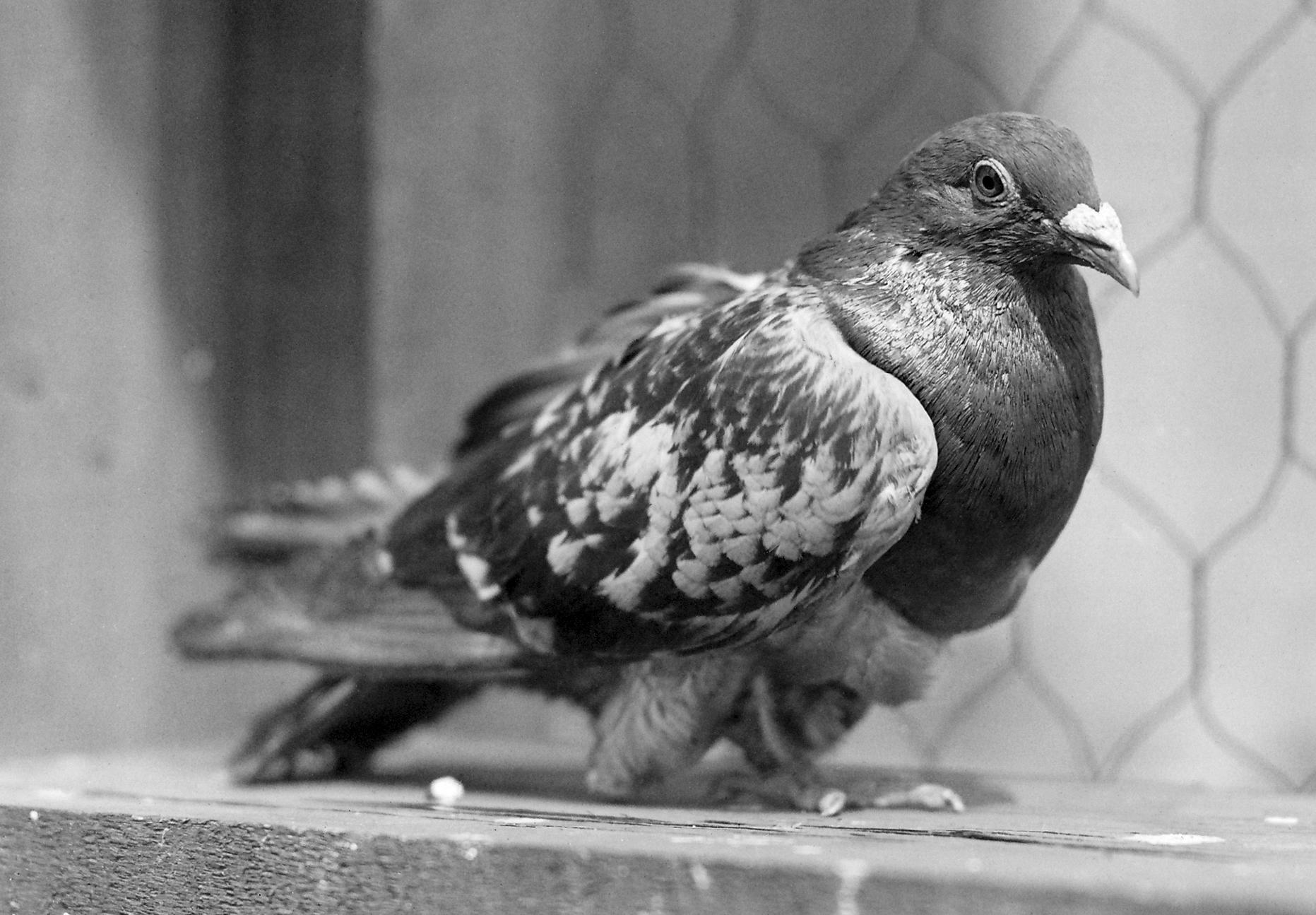
34
Cher Ami. National Archives photo.
who would come to be known as the Lost Battalion. The last bird, an English blue-checked pigeon named “Cher Ami,” released on the afternoon of October 4, brought an urgent message requesting a cessation of incoming friendly artillery. According to popular lore, Cher Ami arrived at its loft with the message tube hanging from the remains of its right leg and a hole across its chest cutting through the breast bone, wounds most likely received from a shell burst or enemy bullet as the bird was escaping the pocket. The message provided the exact position of the trapped men, which facilitated the relief of the survivors on the night of October 7.
Following the armistice, the Pigeon Service immediately curtailed operations. All breeding ceased at the lofts at Fort de la Bonnelle, and loft attendants segregated the birds by sex to prevent unauthorized fraternization. Plans to construct additional breeding lofts at Wassy for the U.S. Second Army ceased. All but two mobile lofts assigned to the First Army, and all those of the Second Army, were concentrated at Vaucouleurs. Initially, the newly constituted
U.S. Third Army did not request pigeon service until in position in the occupied territory, but beginning in January 1919 it operated eight mobile lofts with 640 pigeons.
A HOMECOMING FOR AMERICA’S HERO PIGEONS
The human-animal bond, forged in battle, brought a change to the original plans for the disposition of the AEF pigeons. The army initially informed Russel not to return any birds to the United States, but Russel disagreed. He wrote to Buscall on December 3 to share his opinion that the AEF should make “an exception in the case of the bird which brought in its message after being very seriously wounded.” He directed for this bird to “be sent home in charge of an officer, surrounded by all luxury possible” and photographed with a large placard stating the nature of its achievement. Russel further asked Buscall for recommendations for the disposal of the remaining pigeons. Buscall replied that
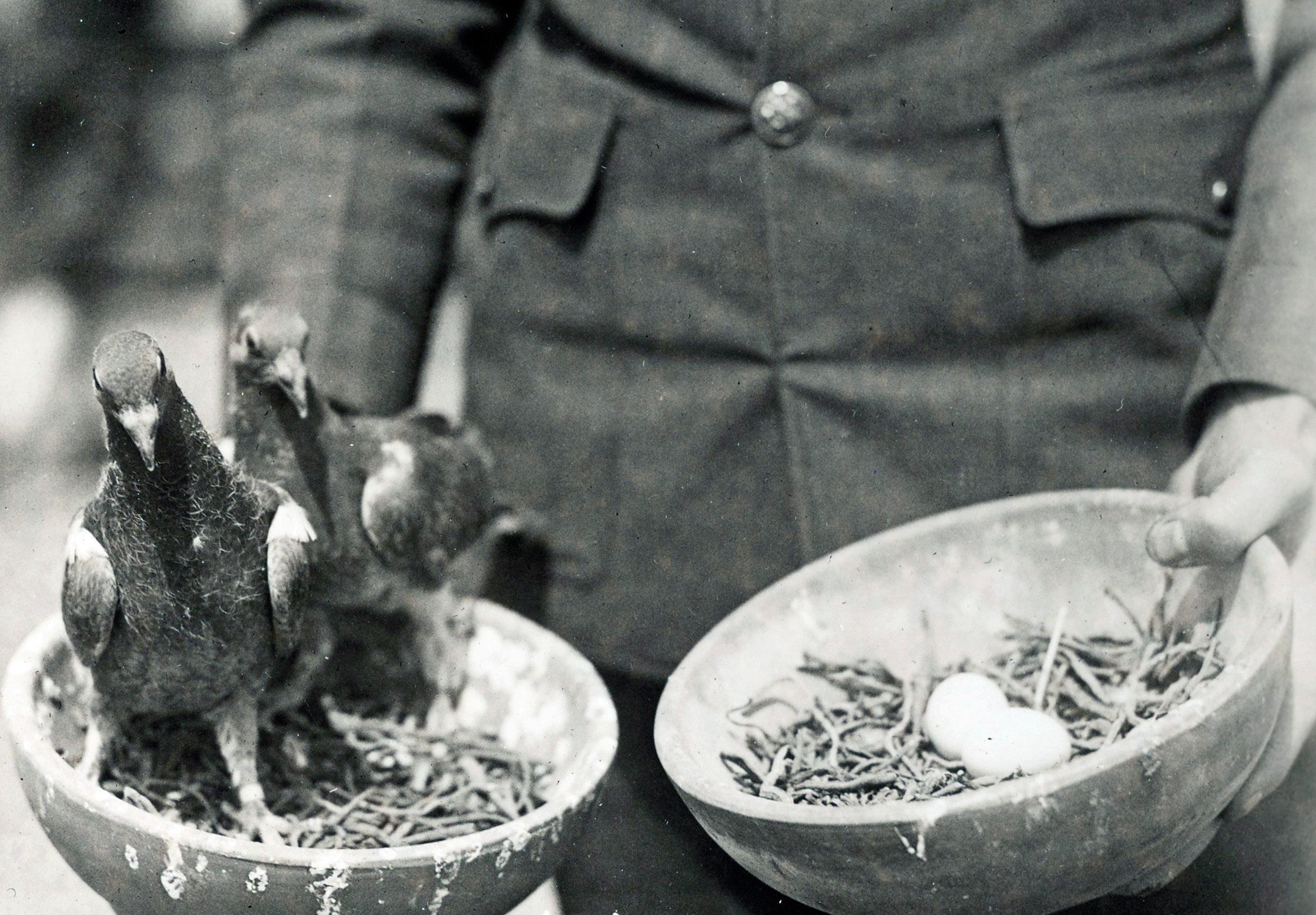
35
Four-week-old pigeons and recently laid eggs.
National Archives photo.
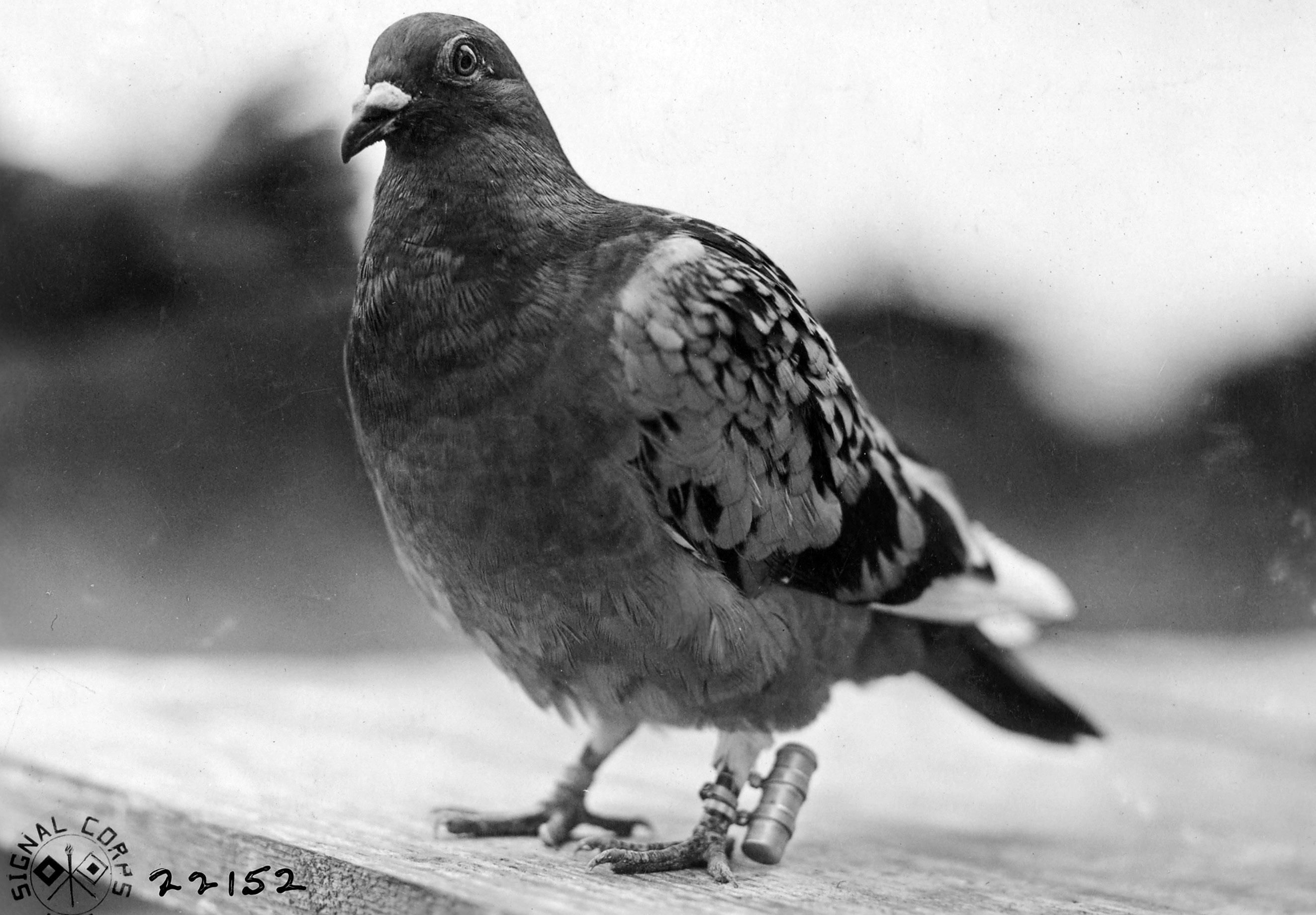
approximately fifty pigeons, “all of which specially distinguished themselves in combat liaison should be taken back to [the] U.S.” as the birds “will be of great value in extolling Signal Corps work especially at the big shows held annually in the U.S.” On December 15, a Signal Corps photographer visited the breeding lofts at Langres and photographed eight hero birds. Before Christmas, Buscall again wrote Russel to recommend that six American hero pigeons and six captured German pigeons be sent to zoological parks in either Washington, D.C., or New York. He added instructions that when any of the Signal Corps birds died they should be properly mounted with the story of their achievements and kept at the Smithsonian Institution. Russel relayed these recommendations to Washington.
In mid-January 1919, Russel received authority from Pershing’s headquarters to publicly auction off the remaining pigeons. Prior to the auction, Russel received a list with descriptions of special birds that were slated to return to United States, including 32 distinguished hero pigeons, 10 captured German pi-
geons, and 132 additional pigeons identified as breeders. The ensuing auction at the Pigeon Service breeding lofts at Langres on February 12 sold 2,049 birds for a total of 10,058 francs. Cognizant of civilian interest in the Pigeon Service personnel, Russel granted permission for the doughboys to bid on birds. As a result, some 800 additional AEF pigeon veterans came home to the United States for private use. General Headquarters, AEF, subsequently cut orders to return all Pigeon Service personnel to the United States except for the thirty-two pigeoneers who were transferred to the Third Army’s 322d Field Signal Battalion to oversee the eight mobile lofts with the occupation force.
On April 16, 1919, the troop transport USS Ohioan docked at Hoboken, New Jersey. Along with men from the 40th Division and other units, John Carney and the twenty enlisted men of Pigeon Company No. 1 disembarked with their 174 feathered comrades. Chief among the ship’s celebrities was Cher Ami, the pigeon credited with saving the Lost Battalion, who had crossed the Atlantic for
36
Pigeon with message tube attached at Fort Lucy, France. National Archives photo.
the first time in the comfort of Carney’s cabin. Dockside reporters interviewed Carney about the pigeons’ heroics and thereafter began spreading Cher Ami’s story across the nation, arguably making the pigeon the most famous bird in the world. After various press events celebrating the pigeons’ achievements in battle, the feathered heroes entered a special “veterans home” loft that was exhibited in Potomac Park in Washington, D.C, per General Pershing’s orders. Officially titled the “Hall of Honor of the American Pigeon Service,” the loft housed the honored birds who also received full pensions in feed. Although not required to work, the pigeons performed daily drill flights, weather permitting. The remaining pigeons went to Signal Corps lofts in the United States, with breeding efforts consolidated at Camp Alfred Vail, New Jersey, in the Signal Corps Pigeon Breeding and Training Section.
Upon his return to the United States, David Buscall compiled a history of the Pigeon Service in the AEF. Drawing on his monthly reports, he outlined the establishment and operations of the service. In his brief concluding recommendations for the future, Buscall focused on personnel issues. He singled out a lack of “officers with sufficient technical knowledge of pigeons” and stated that less than a quarter of enlisted personnel were deemed suitable for pigeon work for similar reasons. Racing pigeon men, rather than pigeon fanciers, were essential for Signal Corps work. Rather pointedly, Buscall noted that “only two [Buscall and Carney] of the six officers detailed with the Pigeon Service up to the time of the signing of the armistice, were racing pigeon men, the others were worse than useless for pigeon work.” He concluded that the expertise of a few officers and enlisted men, combined with the stellar performances of American pigeons of “exceptional quality,” proved to be the main reasons for the Pigeon Service’s success.
Perhaps heeding Buscall’s advice, the Signal Corps retained its Pigeon Service and maintained close relationships with civilian racing pigeon organizations until the dises-
tablishment of the army’s pigeon program in 1957. The hero birds of World War I made guest appearances at national conventions throughout the 1920s, and the Signal Corps entered its newest working pigeons in various exhibitions and races in the interwar period, winning a fair share of events.While participating in various civilian pigeon exhibitions and races, the Signal Corps recruited for the next generation of pigeoneers, seeking men with “pigeon knowledge” to train America’s feathered army messengers.
Within a year of its “hatching,” the Pigeon Service grew from a mere squeaker to a capable communication service. Even as an auxiliary or emergency line of communications, the pigeons proved reliable, with an average success rate over 90 percent and low loss rates when personnel were trained to handle the birds properly. Cooperation with the French and British armies yielded training, specialized equipment, and pigeons for breeding and field work, all of which enabled the AEF to stand up operations with considerable efficiency. Through the civil-military conduit of Buscall and Carney, thousands of high-quality birds and a small, core group of talented citizensoldiers allowed the AEF to field a pigeon force as capable as any other military in the field, ready and able to meet any requirement of the war and to serve the cause with honor.
Dr. Frank A Blazich, Jr., specializes in the American military experience in the twentieth century. A veteran of the U.S. Air Force, he holds a doctorate in modern American history from The Ohio State University (2013). He is Curator of Military History at the National Museum of American History, Washington, D.C.
A version of this article was previously published in the Fall 2020 issue of Army History.
37
★ ★ ★ ★ ★

“A SEARING LIGHT”
General Groves’ Scrapbook and the Manhattan Project
by Melissa H. Davis
This summer’s critically and commercially successful motion picture Oppenheimer has resurrected public fascination with the development and deployment of the world’s first nuclear weapon. Actor Will Roberts, who portrayed George C. Marshall onscreen, prepared for the role using recordings of Marshall’s voice and other resources available in our library. As the world’s premier repository of Marshall materials it is
unsurprising that the library holds rich evidence regarding his role in the wartime nuclear program. What may be less obvious is that the Foundation is home to a significant resource created by Gen. Leslie Groves, a prime figure portrayed in the film by Matt Damon. Groves’s scrapbook detailing his involvement in the nuclear program has been available to researchers since 1964. When it is combined with the aforementioned Marshall materi-
Gen. Leslie Groves and Robert Oppenheimer at ground zero of the Trinity test site, September 1945.
39
FROM THE ARCHIVES
als, it creates a vivid first-person account of a world-changing moment—one that continues to resonate today.
The U.S. wartime effort to develop a nuclear weapon had its roots in the “Laboratory for the Development of Substitute Materials,” later called the “Manhattan Engineer District,” after its location in New York City near the Army Corps of Engineers offices.
Soon nicknamed the “Manhattan Project,” the endeavor was very secret—the small committee running it included Vice President Henry Wallace, Secretary of War Henry Stimson, Army Chief of Staff Gen. George Marshall, chemist Dr. James B. Conant, engineer Dr. Vannevar Bush, Gen. Leslie Groves, and a few others. It was so secret that, for a while, information was not even shared with British Prime Minister Winston Churchill. Marshall indicated that information about the project was only distributed to U.S. generals very late in the war. “We didn’t tell General Arnold until January 1945, that we were trying to make a bomb. General Spaatz didn’t hear about it until Potsdam, and General MacArthur didn’t know until just before the bombs were sent out to the Pacific.”
The Manhattan Project stemmed from
information that the Germans had a nuclear weapons program, so the United States gathered scientists and technicians, led by trained engineer Groves, at facilities in Hanford, Washington; Oak Ridge, Tennessee; Chicago, Illinois; and Los Alamos, New Mexico, to ensure that the United States developed a weapon first. Groves indicated that the research producing nuclear fission was always meant for a bomb to be used during World War II, “From the time that the bomb was first thought of, and Roosevelt was told about it, there was the idea of using it.”
The project cost an estimated $400 million, and it was Marshall’s responsibility as army chief of staff to find the funds without divulging the secret. “I had to get the money and I directed all these preliminary operations and the construction of the affair. Not that I knew anything about the technique at all. I was rather amused at myself because as time wore on, these long statements that would come, that were filled with complicated procedures necessary in these matters and the technical terms involved” which he did not understand.
Groves told a story about Marshall’s first exposure to the Manhattan Project. “I heard the story about General Marshall saying that Trinity
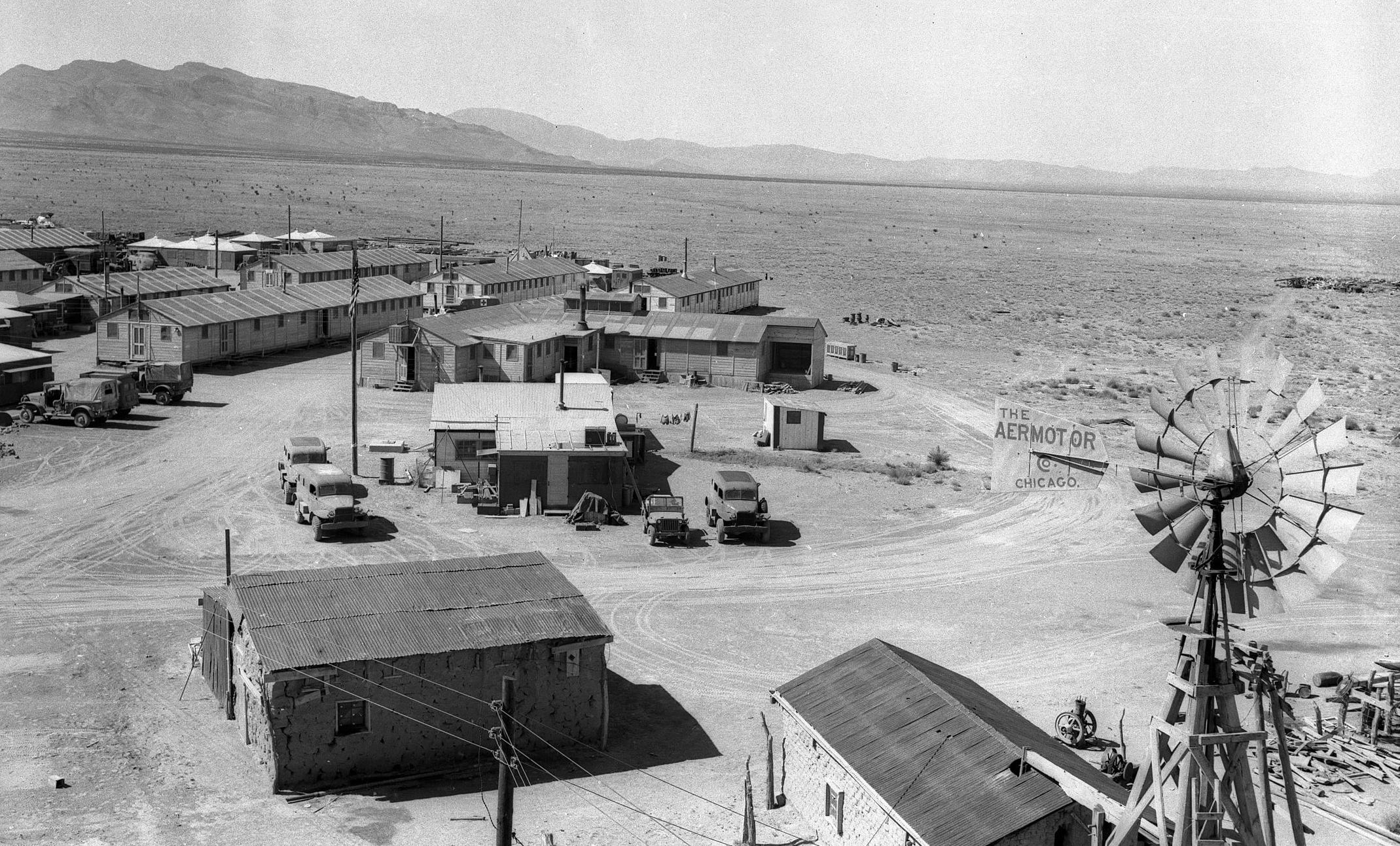
40
basecamp at Alamogordo Bombing and Gunnery Range, New Mexico.
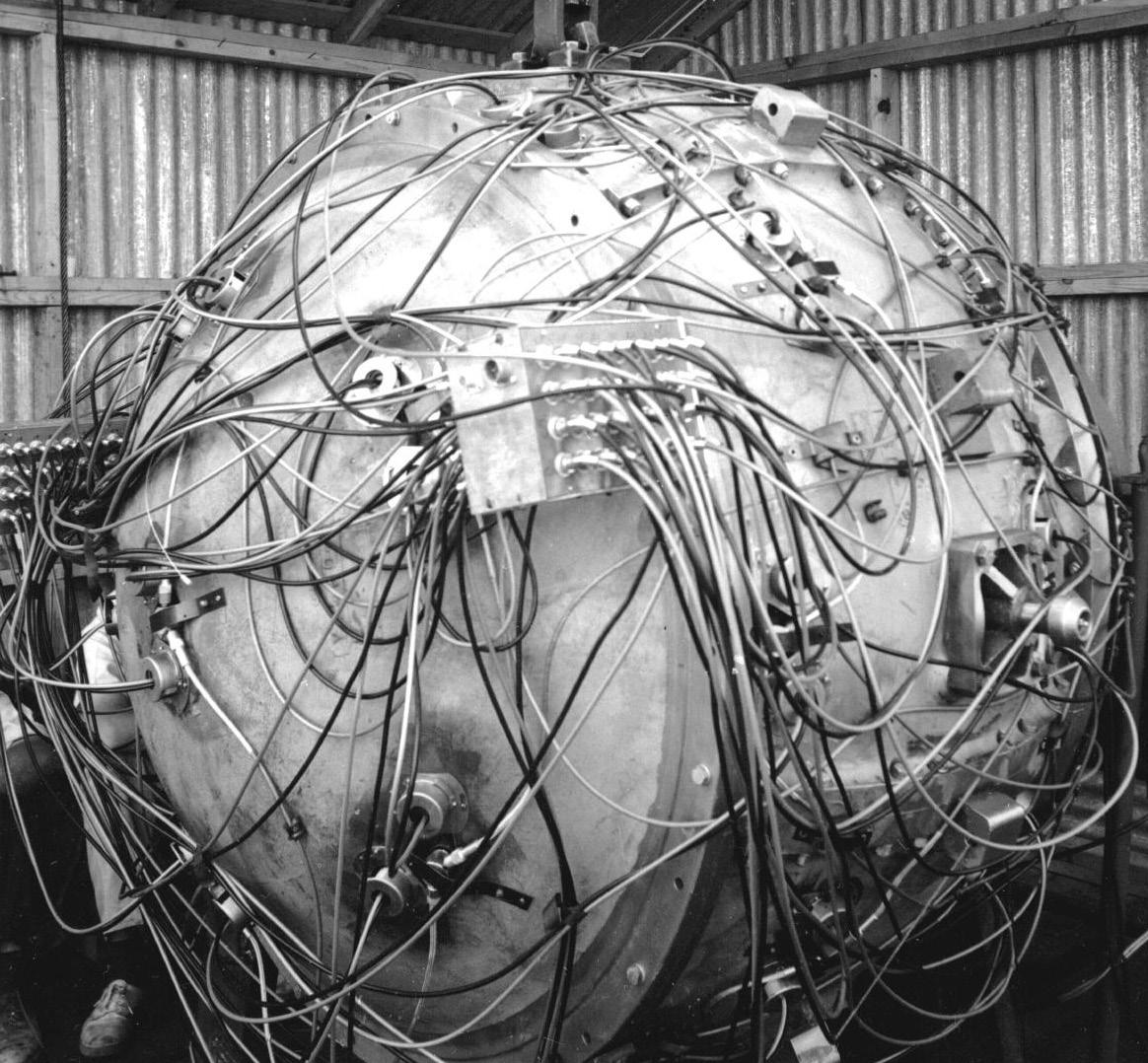
after his first meeting on this subject he went home and looked up what he’d written down, all the words he didn’t understand, and looked them up either in the dictionary or encyclopedia and he found that either they didn’t apply or he couldn’t understand what it was all about, and then he decided he had a war to run and he couldn’t become a scientist.”
Marshall worried about the safety of the Allied military participating in the invasion of Europe and the possibility that radioactive material would be used by the German Army against them. Gen. Leslie Groves recalled, “[Marshall] asked me, ‘We’re taking quite a chance, aren’t we?’ And I said, ‘Yes General, we are taking a chance; but I said if we don’t take the chance, you’d better call off the invasion.’ The thing that bothered [me] was I felt
the Germans . . . wouldn’t have used the bomb against us. They would have just taken radioactive waste…up all the advancing roads, and just spray it out there.”
To alert Gen. Dwight D. Eisenhower of this, Marshall sent a radio message to Eisenhower, so he would be “fully advised of certain materials which might be used against your Armies in a landing operation.” Marshall sent a special courier to “acquaint you…with the problems involved. The matter is of the highest order of secrecy.”
To maintain confidentiality, the radio message was typed by Groves, not a secretary, and the original was kept locked in the safe in Marshall’s Pentagon office.
Authorities in the United States were not sure how far along the German efforts for a
41
“Gadget” under assembly, July 1945.
fission bomb had progressed and who would have success first. To defuse what was a tense environment, there was some gallows humor between generals. Groves remembers saying to Gen. Wilhelm Styer, “The next time you see him [Marshall], tell him that I’m thinking it might not be a bad idea if we sent some agents into Germany and assassinated a few German scientists. Styer came back and he said, ‘Well I asked General Marshall.’ And I said, ‘What did he say?’ I was sure he wouldn’t approve it. The remark was quite revealing. He said, ‘Tell Groves to do his own dirty work.’”
Scientists’ theories became experiments, and one of the most astonishing was the famous first artificial self-sustaining nuclear chain reaction in December 1942 under the bleachers at Stagg Field at the University of Chicago. This effort utilized uranium in an experimental reactor made of graphite blocks called Pile-1, and proved the theory of exothermic nuclear fission would work but a sustained reaction would require significant amounts of the only naturally occurring fissile isotope, uranium-235. As there is a small percentage of the isotope in mined uranium, the uranium-235 separated out in the factory at Oak Ridge was shipped to scientists in Los Alamos by rail in nickel containers inside briefcases, accompanied by army officers dressed as salesman.
There was only enough weapons-grade uranium-235 for one bomb, and the scientists and engineers were confident that the guntype weapon, where the reaction was begun by the “shot” of a mass of uranium-235 into more uranium-235, would work. Developed at Los Alamos, this bomb, called “Little Boy” was shipped for use against Japan without being tested.
In fact, to that point there had only been one nuclear device tested. Nicknamed “Gadget,” it had a solid thirty-five-pound plutonium core, and used an implosion to initiate the nuclear fission reaction, which was a novel theory. It was determined that the implosion bomb—different in design from the gun-type
“Little Boy”—needed to be tested, and that information about nuclear explosions in general should be gathered.
A half hour before sunrise on July 16, 1945, in Bingham, New Mexico, Gadget was detonated on a 100-foot steel tower. Witness Brig. Gen. Thomas F. Farrell, chief of field operations at the project, wrote: “The whole country was lighted by a searing light with the intensity many times that of the midday sun. It was golden, purple, violet, gray and blue. Thirty seconds after the explosion . . . the strong, sustained awesome roar which warned of doomsday and made us feel that we puny things were blasphemous to dare tamper with the forces heretofore reserved to The Almighty.”
Two cleverly worded messages were sent to Secretary Stimson; the first on July 16 said, “Operated on this morning. Diagnosis not yet complete but results seem satisfactory and already exceed expectations.” The next day, “Doctor has just returned, most enthusiastic and confident that the little boy is as husky as his big brother. The light in his eyes discernible from here to high hold and I could have heard his screams from here to my farm.” “Here to high hold” refers to the 250 miles from Washington, D.C., to Stimson’s Long Island home “Highhold”; and from “here to my farm” is the distance between Washington, D.C., and the author’s farm 50 miles away.
In his July 18, 1945, report to Secretary Stimson, Gen. Groves reported that “a lighting effect within a radius of twenty miles equal to several suns in midday. A massive cloud was formed which surged and billowed upward with tremendous power, reaching the substratosphere at an elevation of 41,000 feet.” He also reported that the “steel from the tower was evaporated.” The sand near the explosion site melted into glass later called “trinitite.”
The power of the explosion left an additional 40-ton tower a half mile from the explosion ripped from its foundation and torn apart. Shaken by the destructive force, Gen. Groves commented that “I no longer consider
42
Illustration of the steel tower constructed for the Trinity test found in Groves’s scrapbook.

Handwritten notation from Gen. Marshall on Groves’s memo —included in the scrapbook— regarding the third bomb, August 10, 1945.
the Pentagon a safe shelter from such a bomb.” Japan. Groves tried to get in touch with both

44
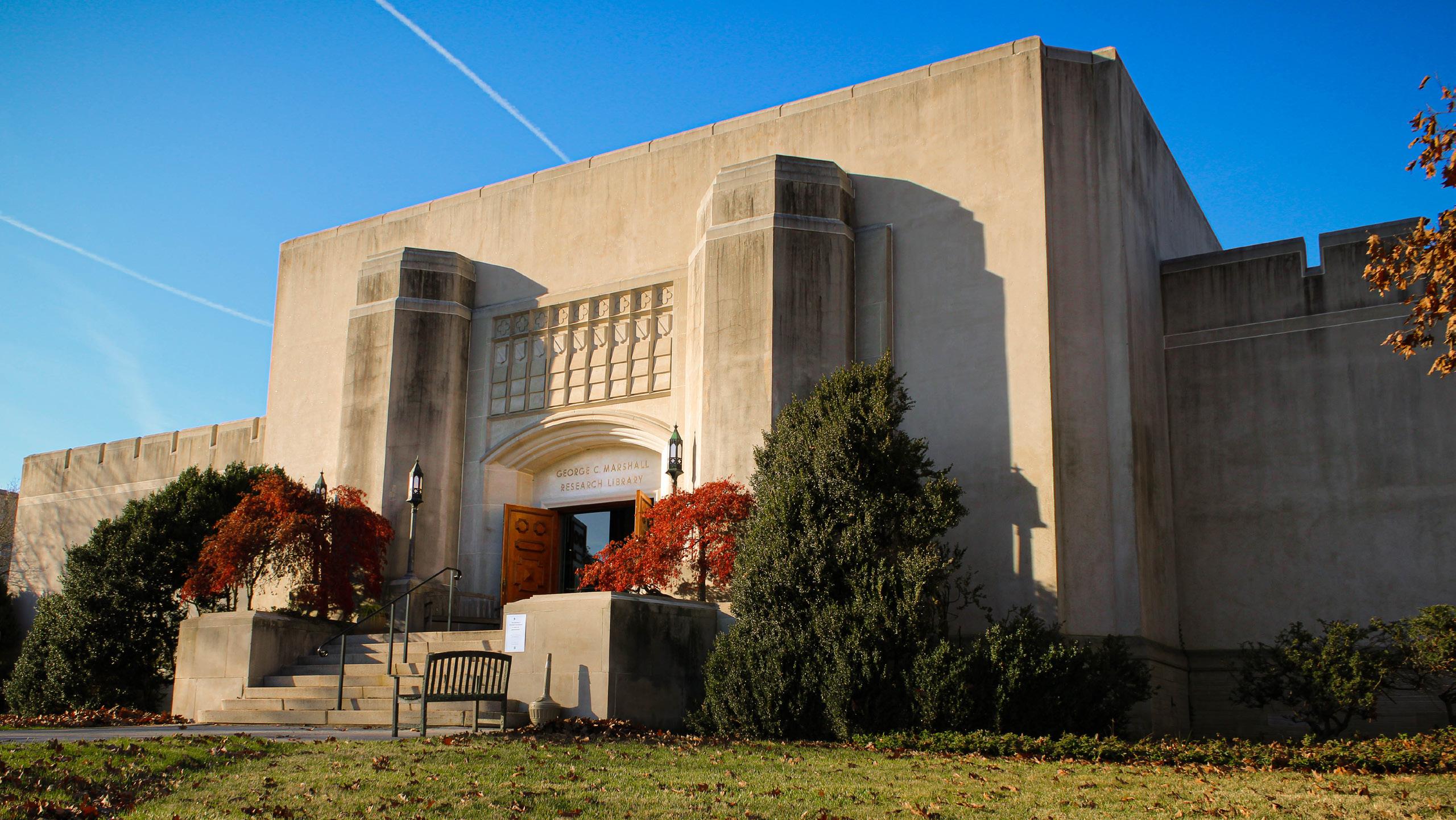
FOUNDATION STAFF
Glen J. Carpenter
Director of Communications and Multimedia
gcarpenter@marshallfoundation.org
Melissa Davis
Director of Library and Archives mdavis@marshallfoundation.org
Alice J. Lee
Special Projects Assistant leeaj@marshallfoundation.org
Paul A. Levengood
President plevengood@marshallfoundation.org
Leigh H. McFaddin
Associate Director of Development and Special Events mcfaddinlh@marshallfoundation.org
Matthew M. Waldron
Chief Financial Officer mwaldron@marshallfoundation.org
John J. Wranek III
Director of Development jwranek@marshallfoundation.org
BOARD OF TRUSTEES
Bennett L. Ross Chairman
Hunter A. Applewhite
C. Russell Fletcher, III Chairman Emeritus
George W. Foresman
David Hein
Walton M. Jeffress, Jr.
Paul A. Levengood
Cynthia Marsteller
Jessine A. Monaghan
Don Mosman
Thomas H. Murphy
Thomas A. Pritchard
Peter Prowitt
Maria P. Rasmussen
David L. Roll
James M. Schmuck
Michael A. Williams
James J. Winn, Jr.
Cedric T. Wins
Robert G. Woodward
Clifford Miller Yonce
COUNCIL OF ADVISORS
John B. Adams, Jr.
Nancy K. Baker
Mark Baruch
Julius W. Becton, Jr.
Ann L. Brownson
Thomas S. Burack
Christine K. Carrico
Robert B. Charles
Richard B. Cheney
Richard A. Cody
Madison F. Cole, Jr.
William E. Dreyer
Charles W. Dyke
Gregory P. Gass
David Hein
Thomas H. Henriksen
Paul R. Ignatius
Walter H. Kansteiner, III
John M. Keane
John W. Knapp
Volunteers
Carroll Comstock
Michael Dale
Ethan Davis
Eryn Davis
Sue Lewis
Andrew G. Kumpuris
Trustee Emeritus
William J. Lemon
Constance A. Morella
Thomas R. Morris
Charles W. Payne, Jr
L. F. Payne, Jr.
Thomas R. Pickering
Kurt A. Polk
James E. Rogers
Gordon R. Sullivan
Richard F. Timmons
Carl E. Vuono
Harry H. Warner
Olin L. Wethington
John H. Zentay
Clare O’Brien
Frank Settle
Missionaries from the Church of Jesus Christ of Latter-day Saints
45


P.O. Box 1600, Lexington, VA 24450
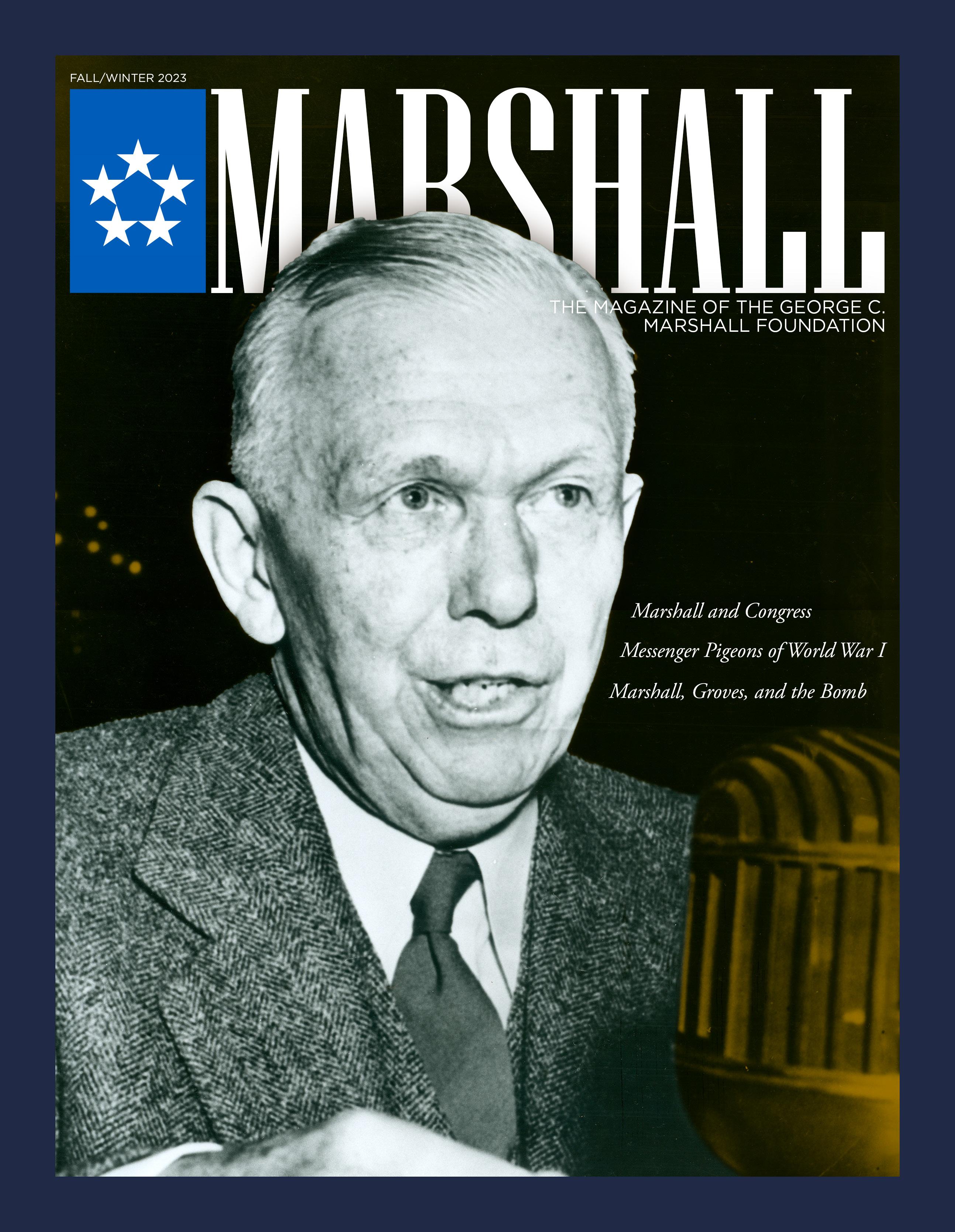
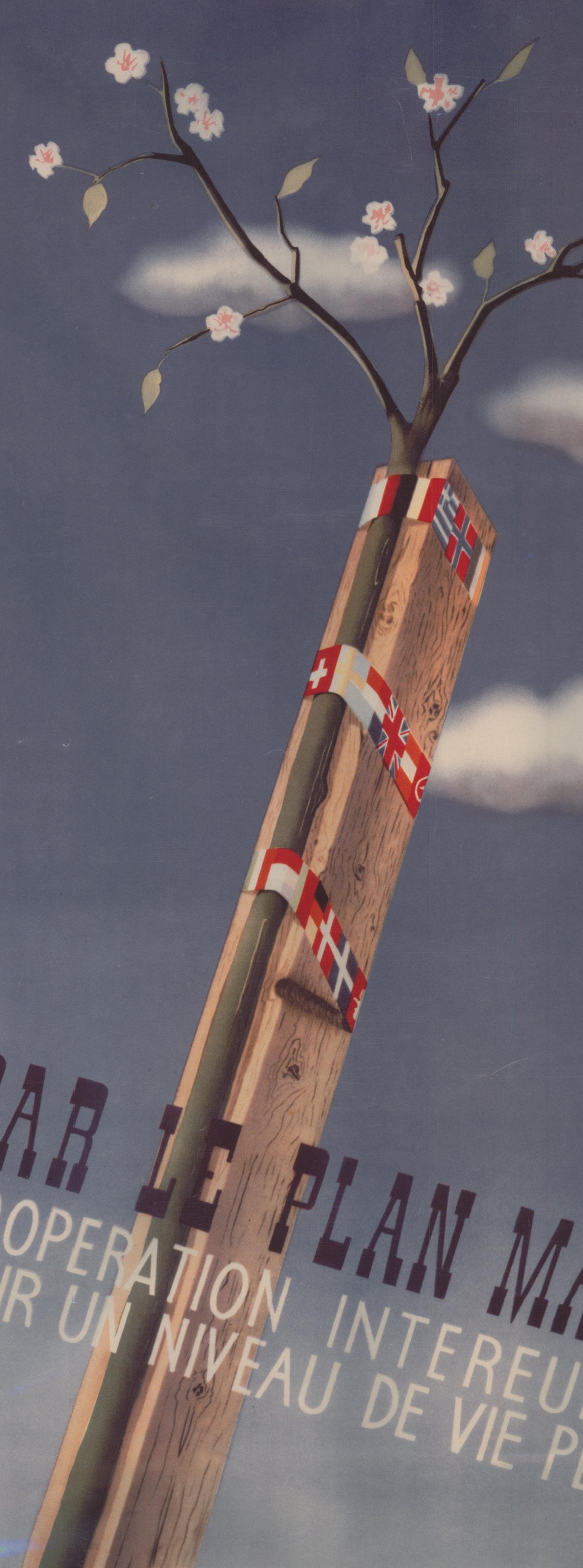
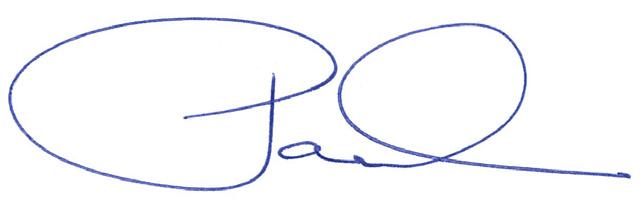 Paul A. Levengood, President Dear readers,
Paul A. Levengood, President Dear readers,
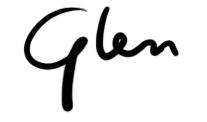 Glen J. Carpenter, Director of Communications and Multimedia
Glen J. Carpenter, Director of Communications and Multimedia












































